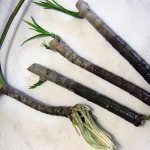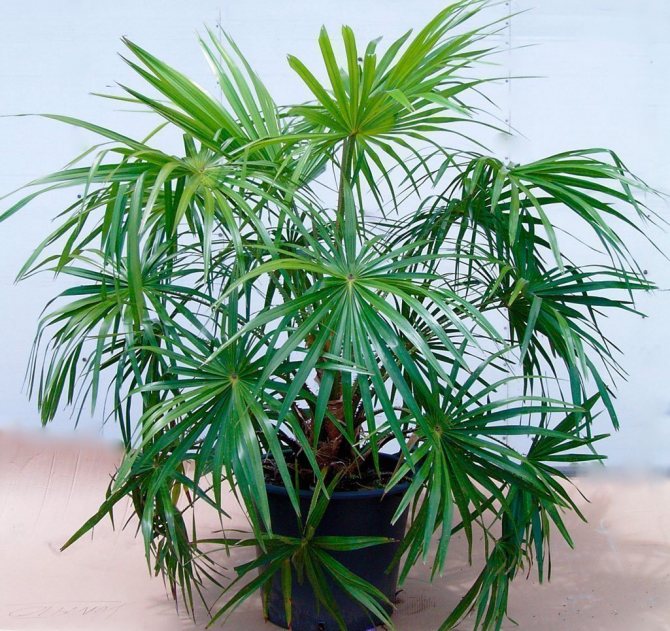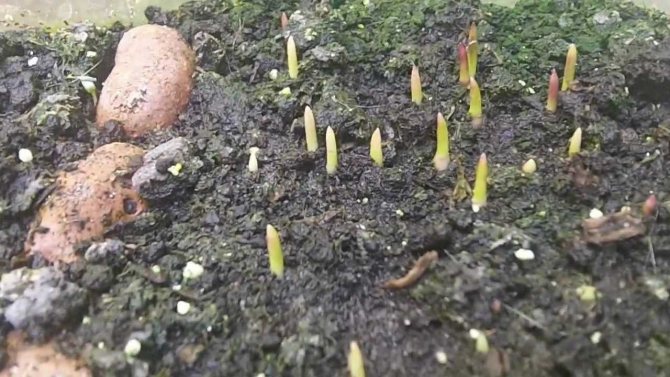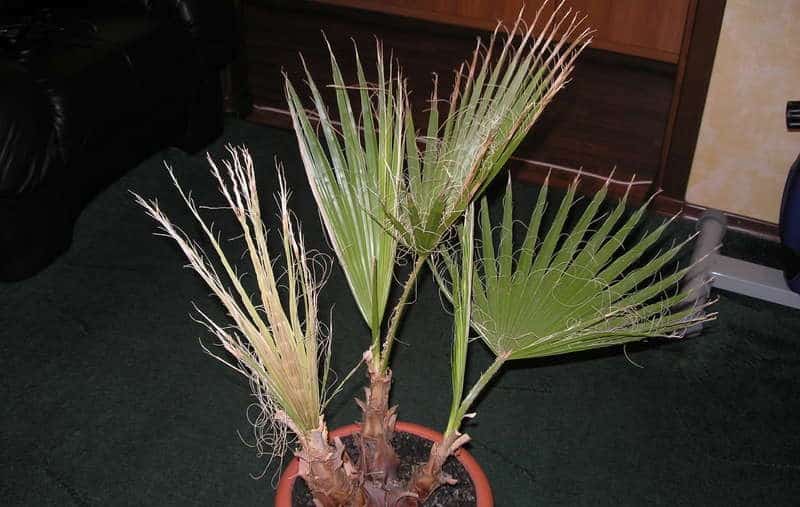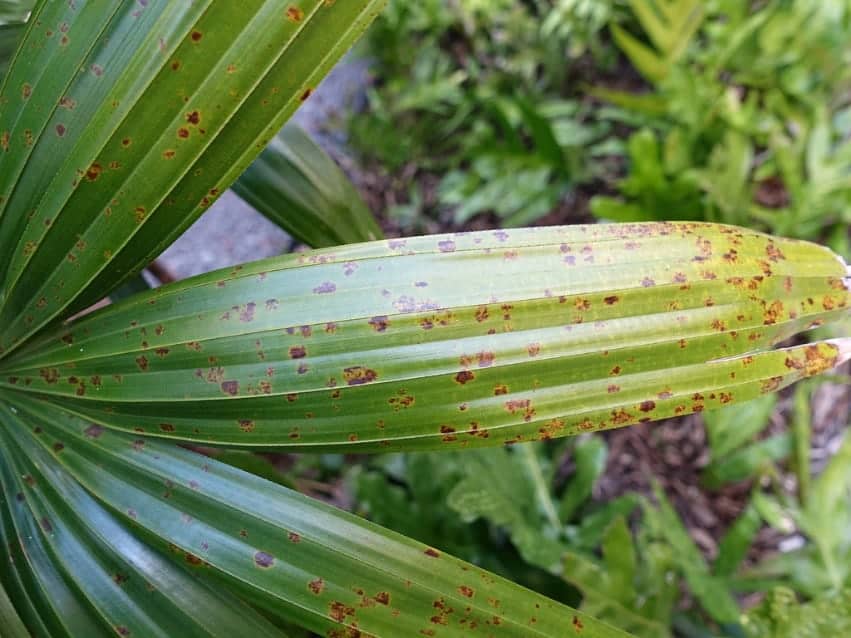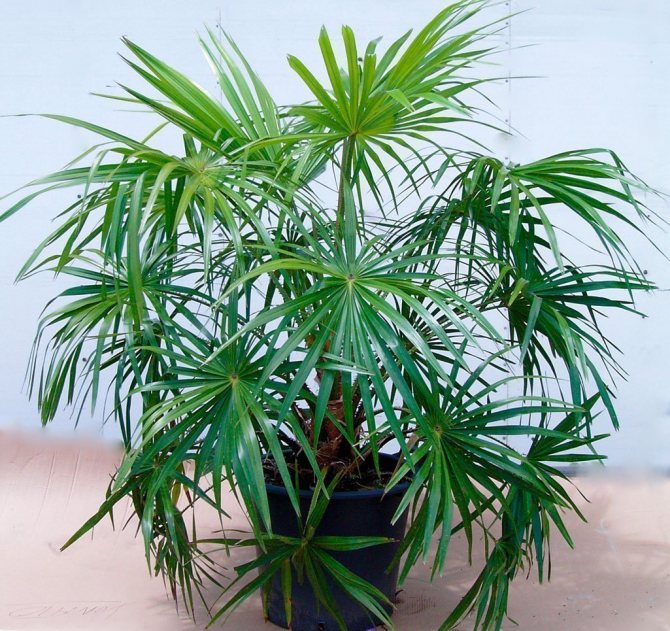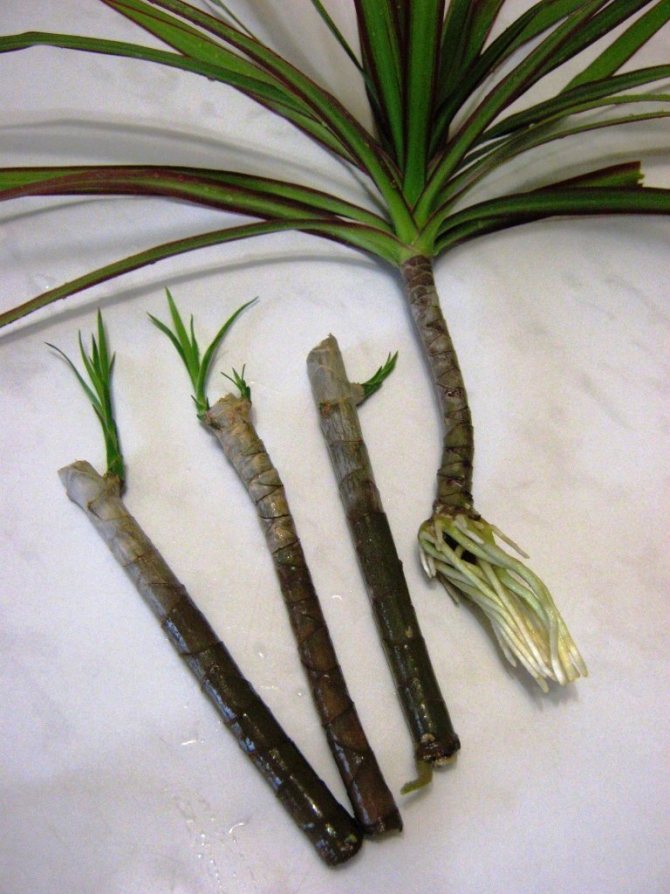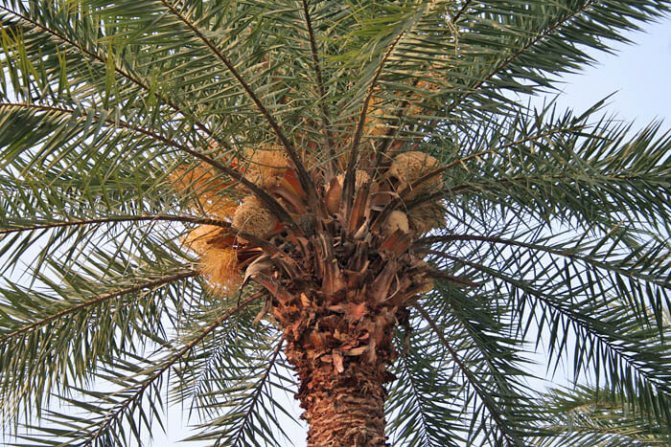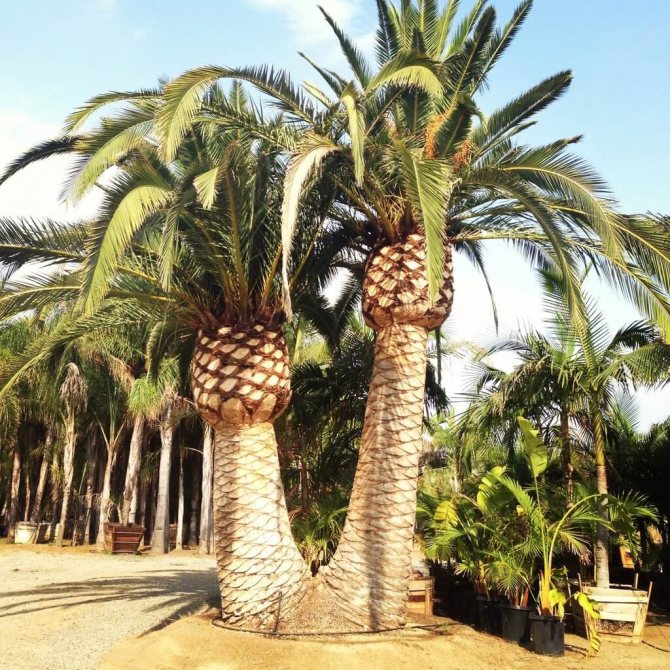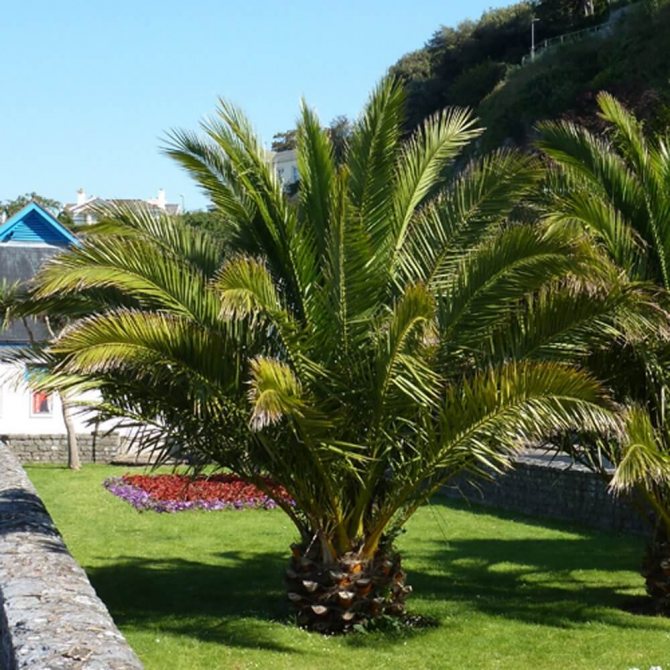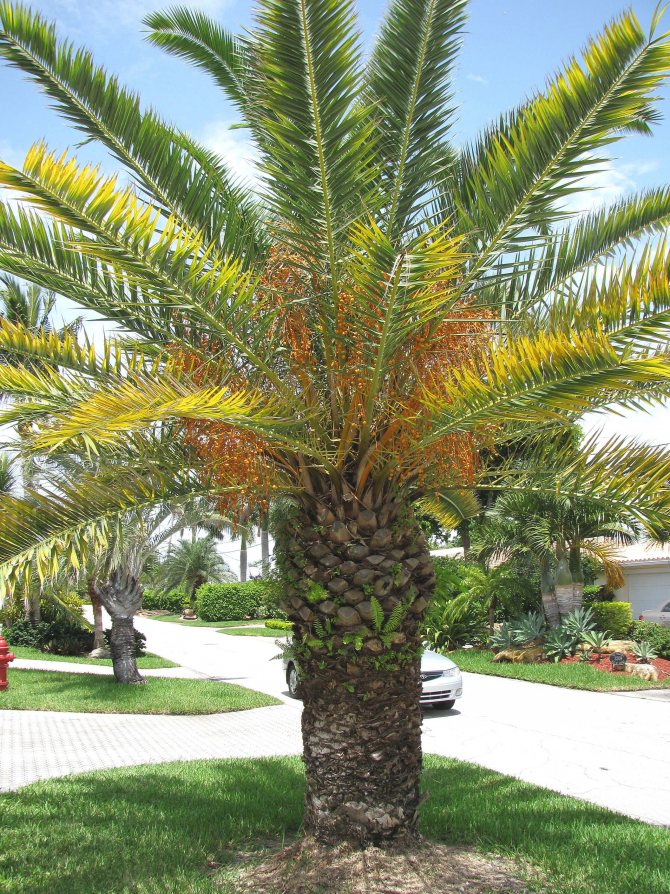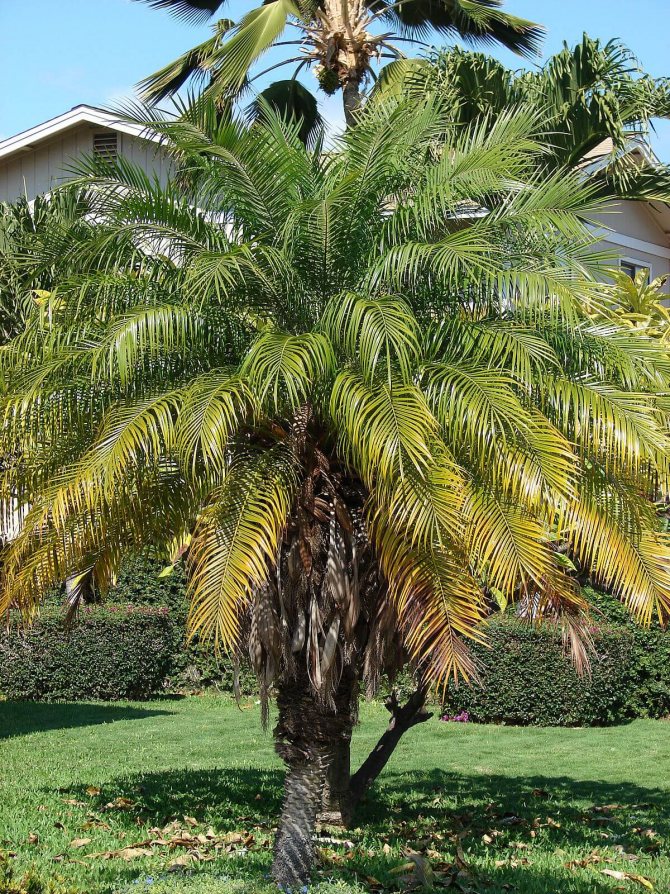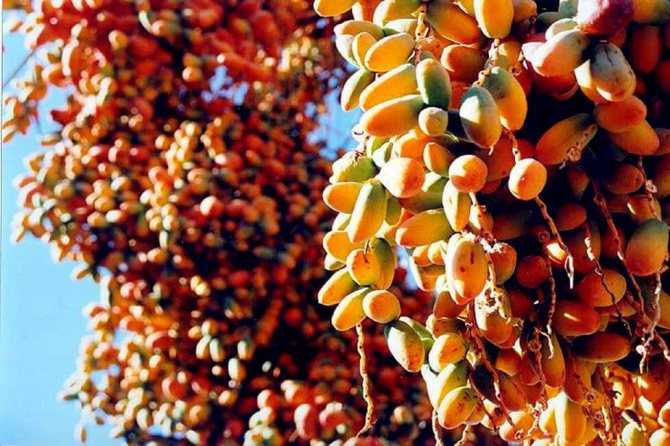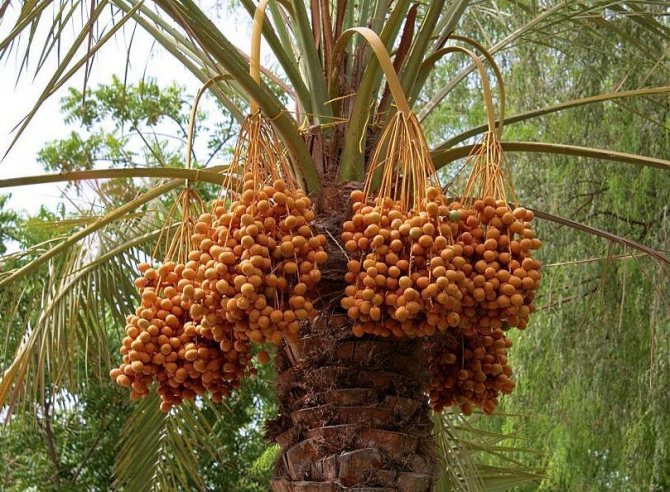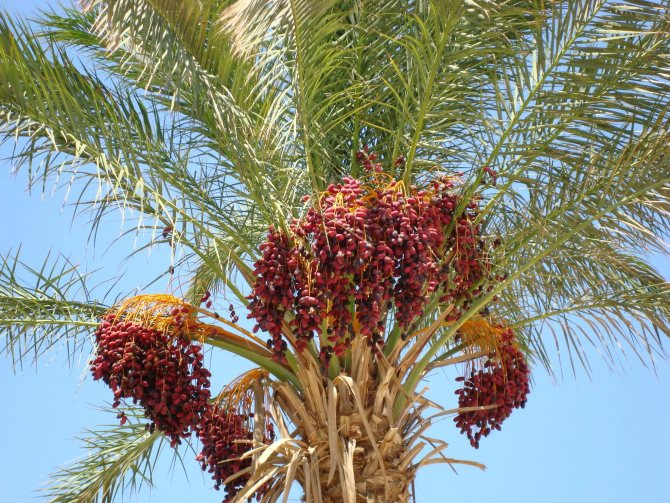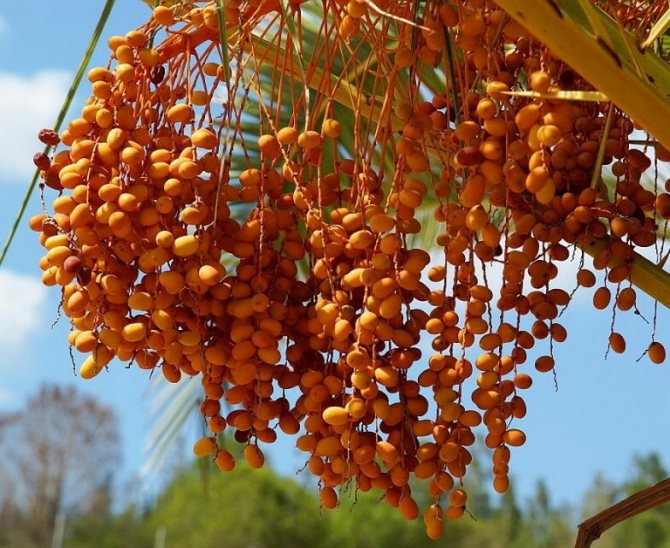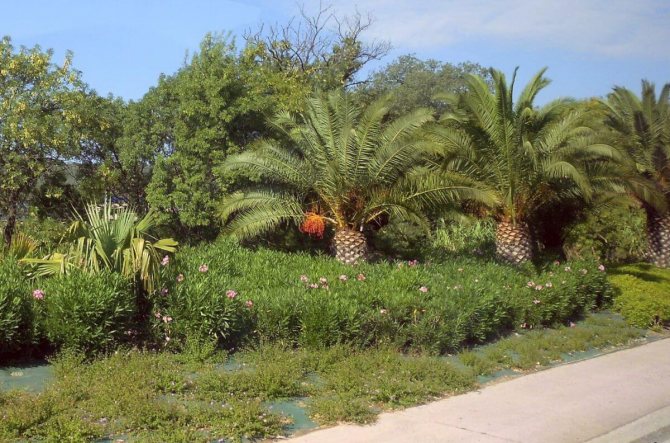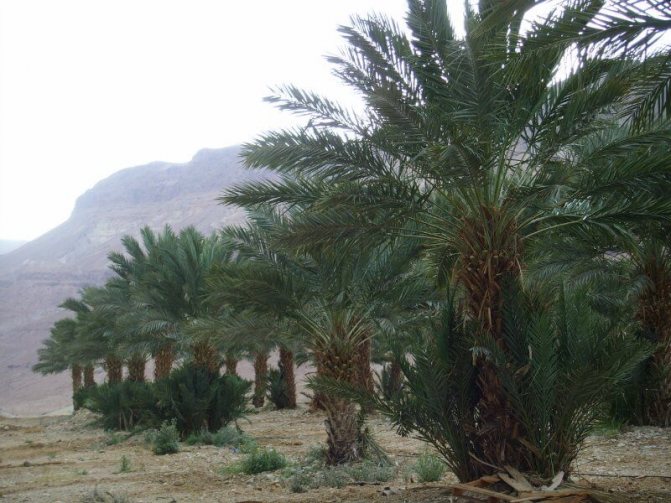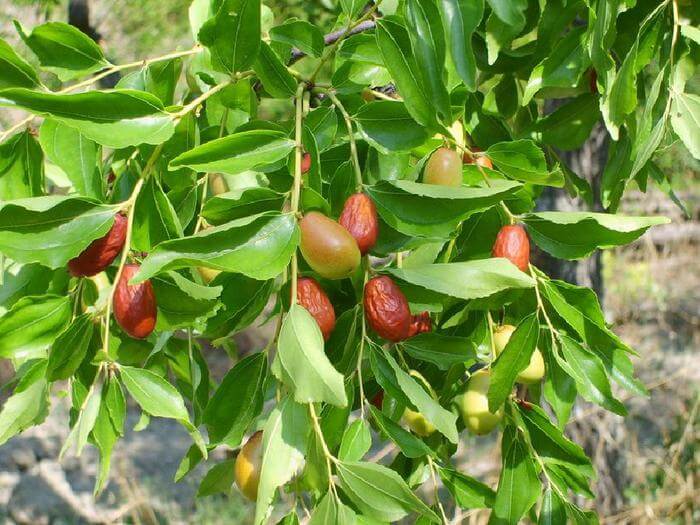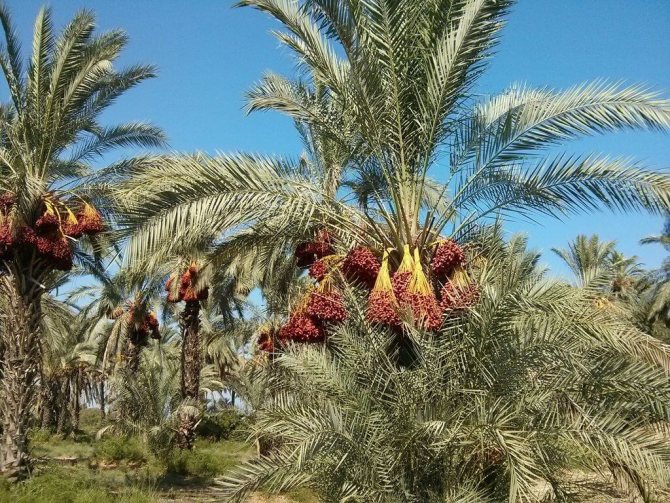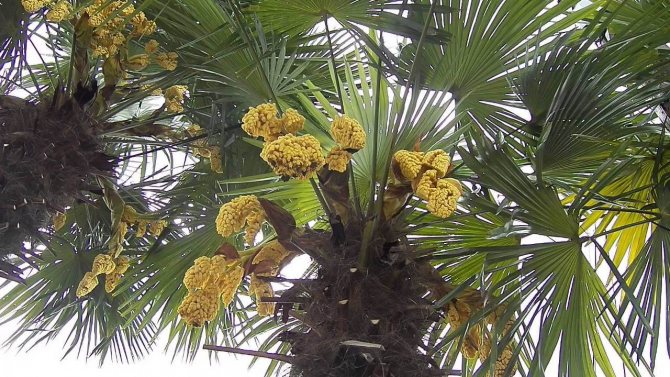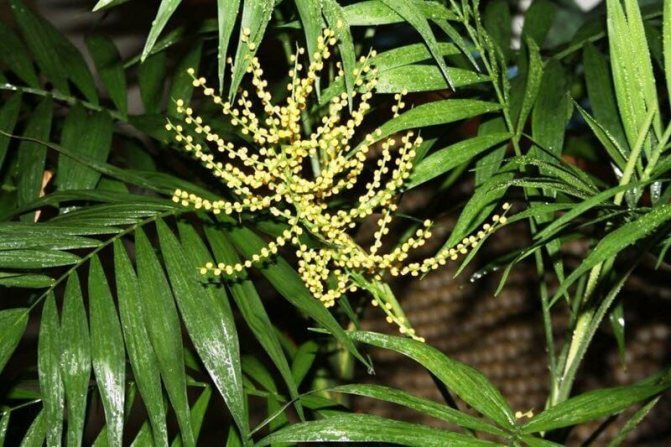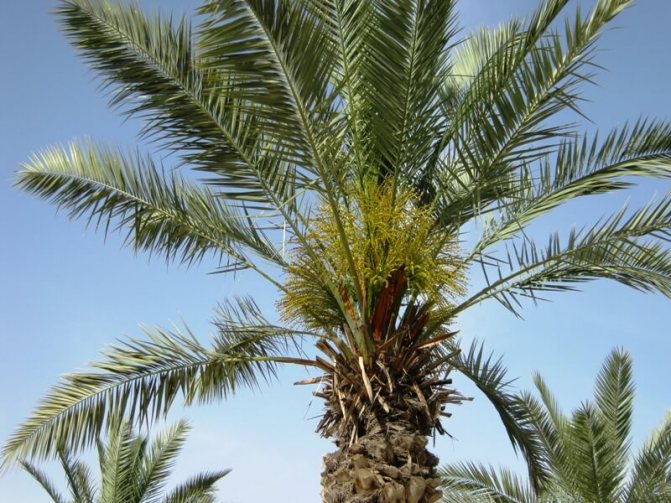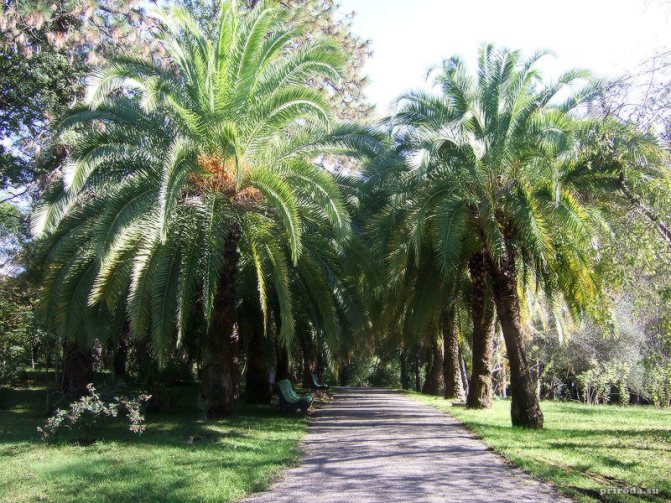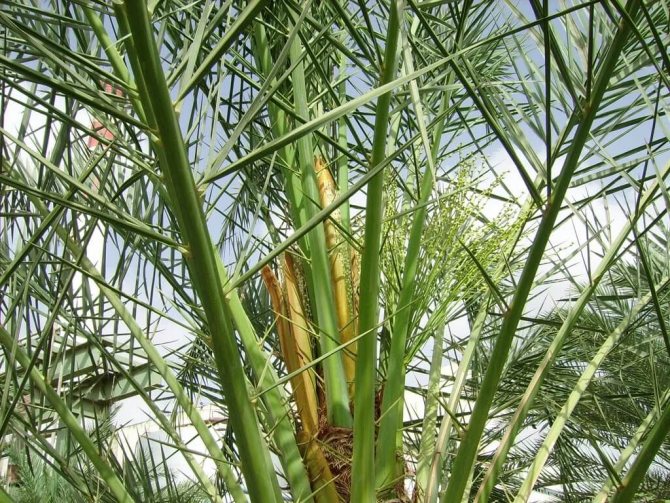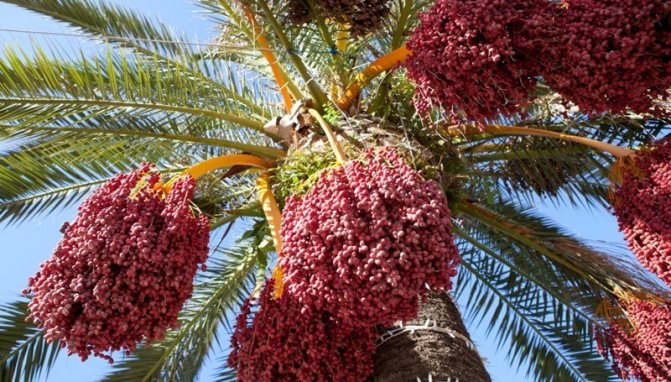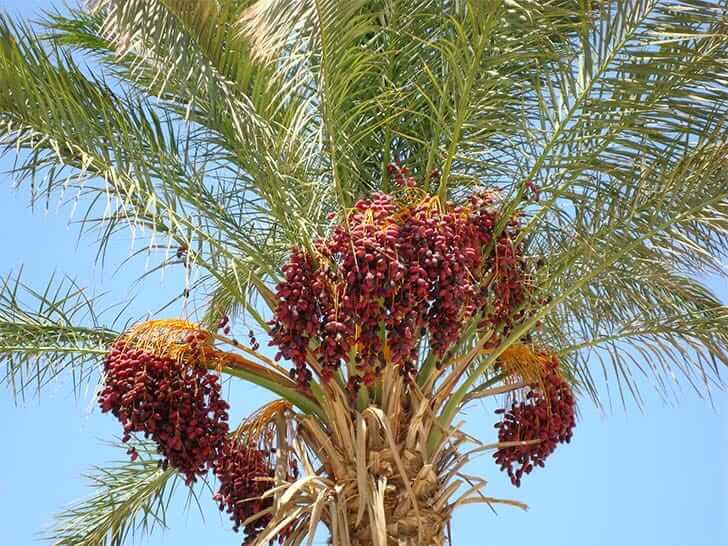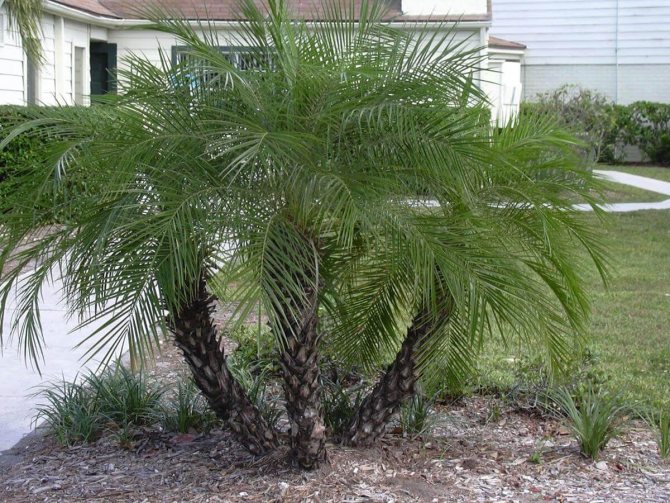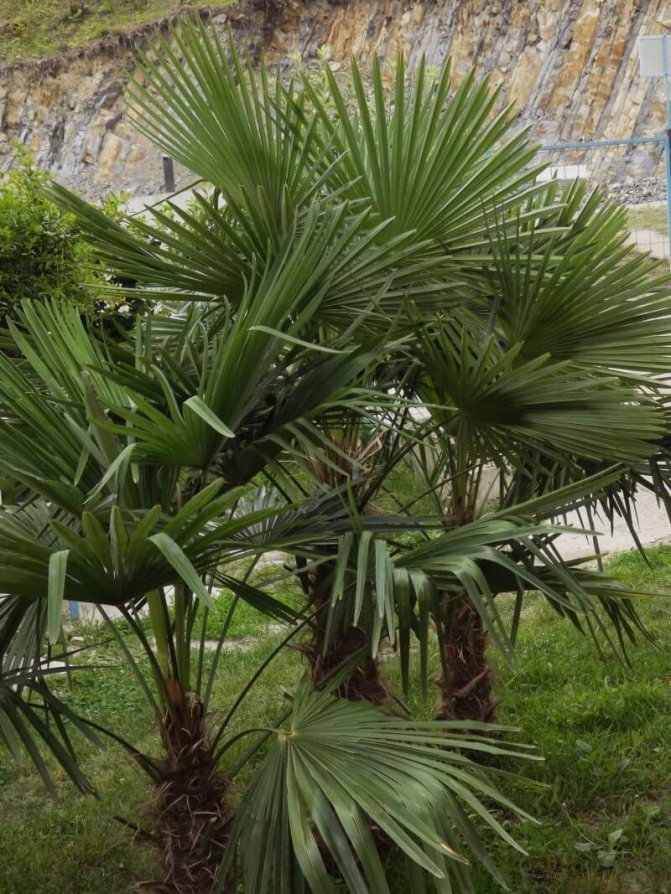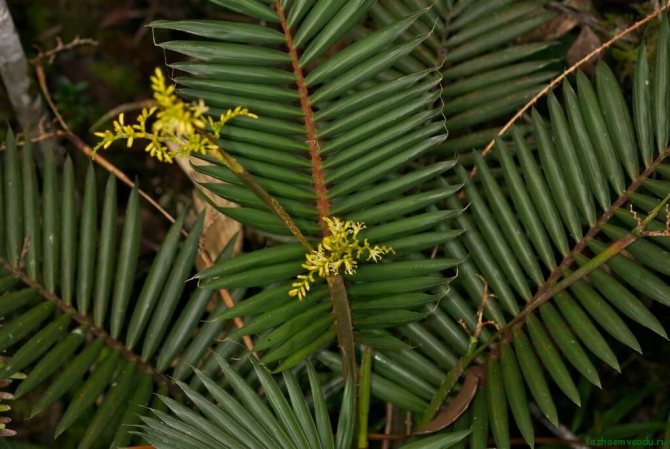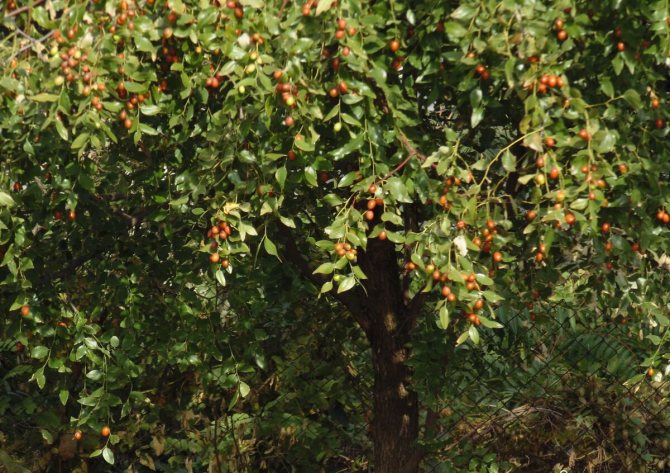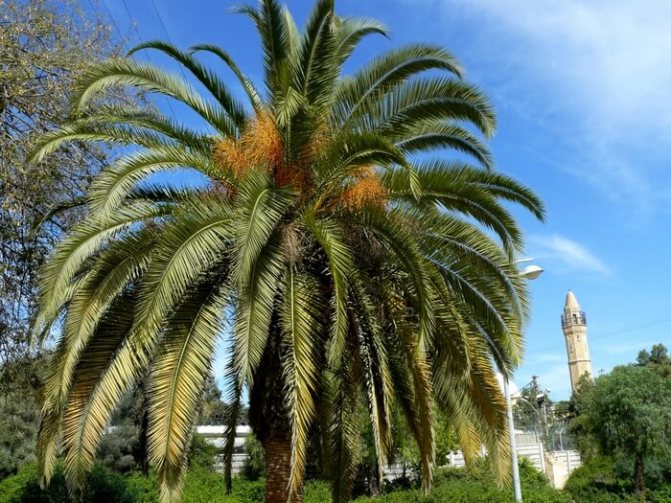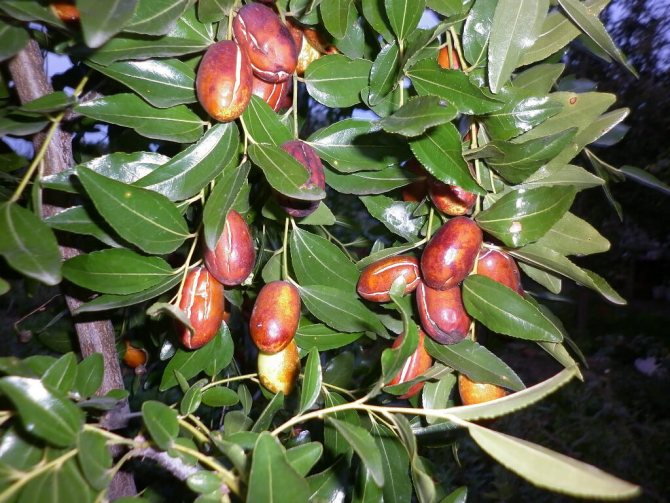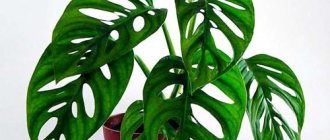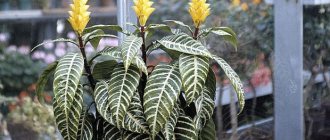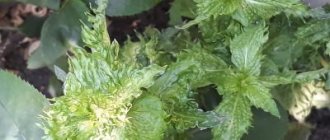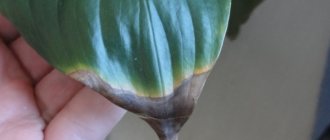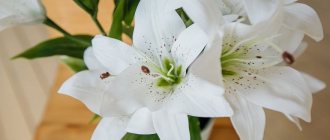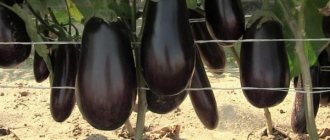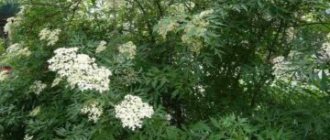The amazing chamedorea palm is a small tree. It grows in the humid tropics of the Yucatan Peninsula, Mexico, Guatemala and Belize. Belongs to the arecaceae (palm) family. It grows rather slowly. An adult plant grows up to 90-120 centimeters in length. It is a small palm plant or a shrub. The trunk of the plant is thin, straight, one to two meters in height and up to three centimeters in diameter. The leaves of the chamedorea palm tree at home are feathery, for the most part, green, wide, pointed. The flowers are small, have no attractiveness to our eyes, it is better to remove them at the bud stage.
It is quite simple to organize proper care at home - all the main points are highlighted in this article. Reproduction and transplantation of the chamedorea palm should be carried out at a certain time of the year. To do this, you need to familiarize yourself with the basic rules.
Further on the page you can see a photo of a hamedorea palm tree from various angles:
Seed propagation
How does indoor palm propagate by seed? Seeds multiply all types of palm trees, without exception, and hovea, washingtonia, li-kuala, trachycarpus and livistona - only by seeds.
The longer they have been stored, the less chance of waiting for germination, be sure to read the labeling and do not buy seeds with an expiration date.
Seed preparation
Be sure to free the seeds from the outer shells, if any, and place for a few days. into warm water for swelling.
The place for the container with seeds should be warm, up to 30 degrees, the water can be changed. If the seed coat is very strong, it should be filed with a rasp, but very carefully, without damaging the seed itself.
Sowing

Suitable for sowing and boxes, and plastic jars, and disposable cups, but if the seeds are large, you need to pick up a larger container, if it is a coconut - do not forget to put it on the side seam, this will accelerate germination.
Fill prepared containers substrate from garden soil and sand in a ratio of 2: 1, the top layer should be sandy, and sow the seeds to a depth of 2 or 3 centimeters.
Sandy soil is washed out during watering, in order to avoid this it is worth using sprayer... The containers need to be covered with polyethylene, with its help a greenhouse effect is created, so necessary for plants during germination.
When will the seedlings appear, place them in a brighter place, but avoid direct sunlight, at this stage of development it is very harmful. The grown seedlings from the box must be cut into individual temporary pots with the same substrate, after picking, be sure to cover the plants with plastic bags or glass jars, so they will take root faster, since there is practically no evaporation.
Gradually release young plants over time from film shelters, let them adapt to the climate of the room and grow up before being transplanted to a permanent place.
About pests affecting indoor palms
Indoor trees are less susceptible to being attacked by voracious insects, but there are still risks of infection.And since parasites tend to multiply quickly, causing irreparable harm to the plant, they should be fought at the first signs of damage. Who can the owners of palm trees face?
Shield and false shield
If the foliage of the palm tree is covered with tiny brown droplets, it means that it has been attacked by a scale insect. The insect feeds on fresh plant sap, depriving it of valuable nutrients and leaving pale areas underneath. In addition, scale insects produce a sticky coating, similar to white dots.
These pests are much more resistant to insecticides than other insects, as they are protected by a special shell, therefore it is recommended to use intestinal agents against them. When eating the juice of poisoned leaves, the scabbard paralyzes, which leads to its death.
In addition to insecticidal treatments, the crown of a tree can be treated with an alcohol solution or water-oil emulsion. In addition, it is useful to replace the top layer of soil with fresh substrate.
And there are also many folk recipes for removing these small pests. For example, you can rid a palm tree of scale insect larvae by the following means:
- Infusion of dandelion leaves and roots - 30 g of fresh raw materials per liter of water.
- Tincture of potato tops - 100 g of fresh herbs per liter of water.
- A decoction of leaves and stems of tomatoes - 400 g of crushed mixture per liter of water, the composition is diluted 3-5 times.
- Garlic tincture - cloves of garlic are chopped with a knife or choked, filled with water: 150 g per 0.5 l of water. Before use, the product is diluted - 5 g per liter of water.
As a rule, several treatments of the plant are required, and in addition, it is useful to use folk remedies for prevention.
Mealybug
Another unpleasant "comrade" who, in combination, is a close relative of the scale insects. He is also not averse to settling on indoor flowers and feasting on their fresh juice.
Mealybug - 3-5 mm insect with an oval body, painted in a light tone. It reproduces at the "speed of light", after a couple of days the larvae of the worm can fill the veins, ovaries and even get to the root system of the palm tree.
To save any houseplant, you should act immediately - the worm is able to exterminate even a large palm tree in a short time:
- The parasites are collected by hand.
- Severely damaged leaves are cut off.
- The leaf blades must be treated with a soapy or leafy solution, removing the sticky exudate that the worms leave on them. You can increase the effectiveness of the procedure by adding onion or garlic juice to the composition.
- If the colony of mealybugs has increased significantly, then it is worth resorting to the use of biological preparations - lepodocides containing toxins. They are applied only to areas affected by parasites.
- The worm can also be removed by means of insecticides. The funds are used for spraying the crown or shedding soil.
Among the most effective folk remedies for the spiderworm, flower growers distinguish the following compositions:
- Infusion of leaves and stems of tobacco - 20-25 g per 0.5 l of water. Before use, it is diluted with water in a 1: 2 ratio.
- Infusion of fruits of bitter pepper - 100 g of crushed raw materials are poured in a liter of water.
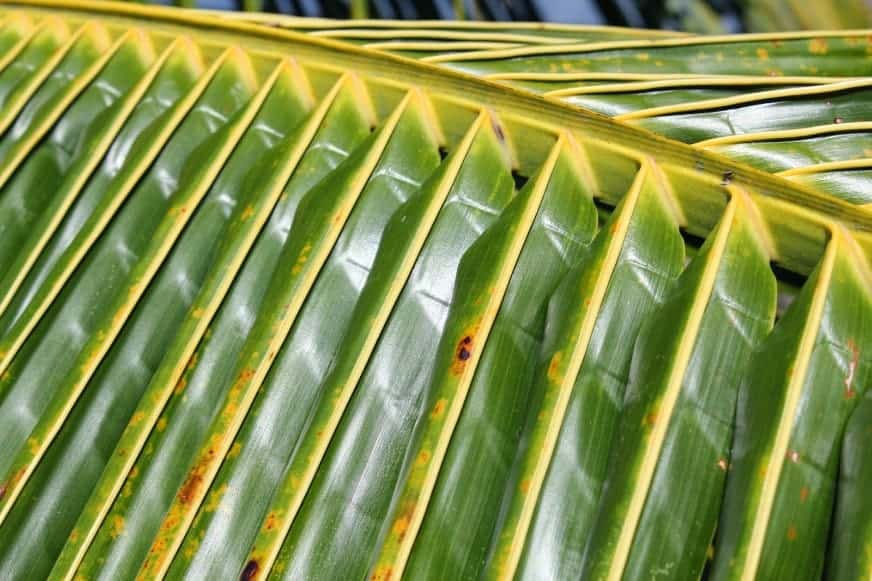

Vegetative propagation
The main part of palm species does not branch, forming only one stem, but there are exceptions, they are mainly grown in the room.
Such palms are called cluster, of which the most common are chamedorea, Robelen's date, cariota, hamerops, chrysalidocarpus. They can be propagated by root suckers.
Offspring
On the roots that are close to the soil surface, root suckers are formed, rooting, they form an independent plant. Wait for rooting process of a palm tree, and using a sharp knife, separate the young plant from the mother bush, sprinkle the cut with ash.
The offspring is already sufficiently developed and it can be planted in a permanent place, but watering properly.
Tops
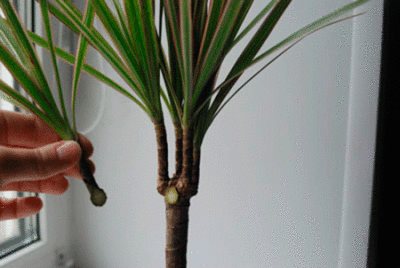

Actually, a palm tree cannot reproduce in this way, but there are plants very similar to them, which very easily reproduce vegetatively. More often than others, dracaena and yucca are grown in our homes.
To separate the top use a sharp knife or a small garden hacksaw, leaving a section of the stem to sink into the substrate. Leaves do not need to be dropped, most likely they will rot and will need to be removed, since the survival rate of dracaena and yucca is 90%. You can plant a plant in a permanent place, the composition of the soil for all plants of this type is one - 2 parts of humus, 1 part of garden soil, 1 part of sand.
Remember to cover the top with a plastic bag for a greenhouse effect. When the rooted plant releases young leaves at the top, the bag can be removed.
Cutting location does not need smearing and dusting, nature has provided for such nuances, the self-healing process begins immediately, and young shoots sprout abundantly from the buds below the cut.
Shoots
Shoots do not have their own roots, but they are easily formed when planting in the ground, it is necessary very neatly separate them from the mother plant and put on rooting with further planting in a permanent place, you can immediately in a permanent place. Don't forget to create a greenhouse effect.
Cuttings
A stem without a top can be divided for cuttings of 15 or 20 centimeters and put them in water until roots form, and then plant them in a permanent place. You can immediately plant the cuttings in the substrate, water it properly and cover with a plastic bag until rooting is complete.
Temperature regime
Home palm care requires recreating tropical conditionsalthough today there are many varieties that are suitable for growing even in cold rooms. Let's consider each of them.
Palms for warm rooms
Such varieties of domestic palms require keeping in warm rooms with an air humidity of more than 50% (the higher, the better for the plant). These varieties include:
- Kariota, or Fishtail
Is the only domestic palm tree that has double-split leaves. With a minimum of soil, this palm grows as quickly as possible, although when grown at home it can have a light green leaf color. It is necessary to grow in well-lit rooms, regularly watering and spraying.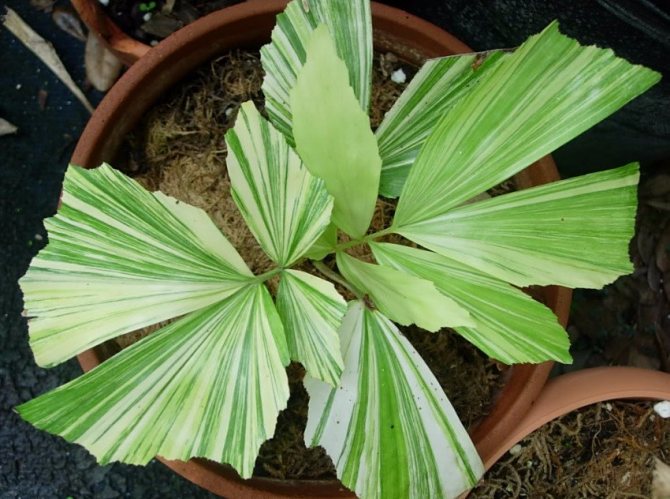

- Hamedorea
- a palm tree that is very heat demanding, but very tolerant of arid cultivation. Slow growing, can be kept in dimly lit rooms. It is often affected by spider mites, especially if it is rarely watered. - Date Robelena
- a very common palm tree, but demanding on moisture and lighting. If these two factors are insufficient, brown spots may appear on the leaves.
Palm trees for temperate spaces
The most popular palm varieties that do not require additional heating are:
- Hovea Belmora
- a very hardy palm tree that is capable of maintaining the dark green color of its leaves even in poor light. Requires regular watering and spraying. - Rapis
- a small palm tree that has fan-shaped leaves. This palm is less demanding on watering, but it can only be grown in well-lit rooms and not in direct sunlight. The growth of the palm is slow.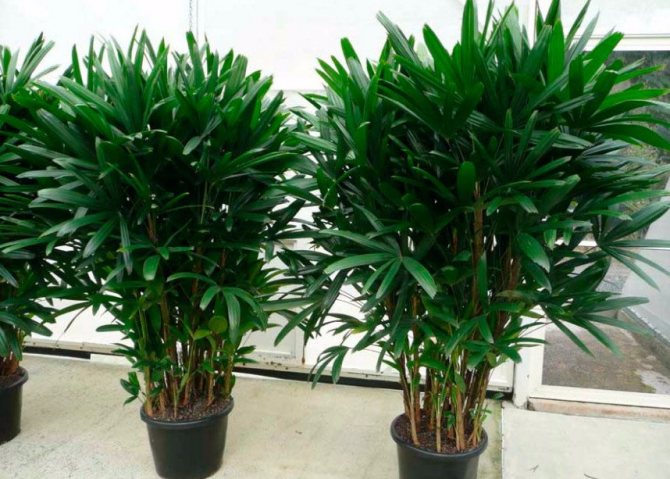

Palms for cool rooms
There are varieties of home palm trees that take root even in cool office spaces and home verandas. Among them in ordinary flower shops you can find:
- Hamerops
- the most hardy palms, which grow even outdoors in the southern regions. They are able to survive indoors with a predominance of artificial light, but at the same time they turn pale. When grown outdoors, the leaves will be shorter, darker and healthier. - Trachikarpus
also known as the Palm Windmill. A very attractive plant that, despite its resistance to cool air, still needs to be grown near natural light and provided with regular watering and spraying.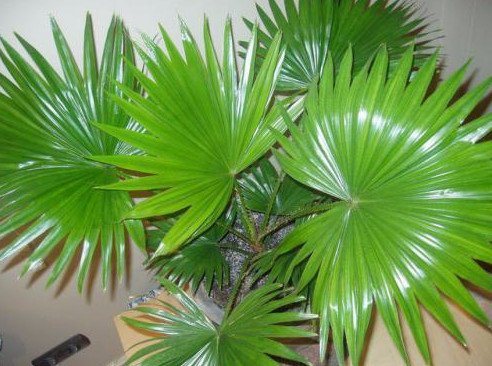

Choosing a pot
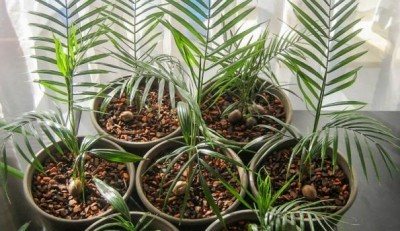

Primarily, the pot must fit the plant in size, you do not need to buy pots for growth, as you grow, transplant into a more spacious container, besides, your taste may change by this time.
Ideal for all types of indoor plants ceramic pot, the palm tree is no exception, it is environmentally friendly, it regulates the water and air balance of the root system.
They also live in plastic containers and pots, but it is necessary to loosen the soil more often and arrange drainage more reliably, all kinds of wooden containers are good for a palm tree, they well emphasize the decorativeness of a palm tree, but they themselves require care when in contact with water, it is easier to use them as pots.
Alternaria
Unfortunately, dracaena can pick up a fungal disease, and then it is clearly not possible to get off with just careful care. Quite often, alternaria is found, which manifests itself in the appearance on the leaves and stem of the flower of dry round spots of a light brown shade with a white dot in the middle. If you look closely, you can also see dark and light specks. As Alternaria progresses, the center of the spots turns black due to fungal spores.
To get rid of the misfortune, you need to apply a solution of fungicides. A foundation is optimal at the rate of 10 g per 500 ml of water. Also, a solution of topaz, oxychoma and other agents in which copper is present is able to defeat the fungus. For reliability, dracaena should be processed three times, with an interval of 1.5 weeks.
The soil
The palm tree grows well on rich light soils, and most often the following is prepared for it structure: 2 parts of humus, 1 part of garden soil, 1 part of sand, it is advisable to use river sand, but despite the good water conductivity of this type of soil, be sure to place a drainage from broken red brick on the bottom of the pot, and make sure there is a hole in the bottom of the pot, an excess of stagnant water will lead to decay of the roots and the inevitable death of the plant.
If you find an error, please select a piece of text and press Ctrl + Enter.
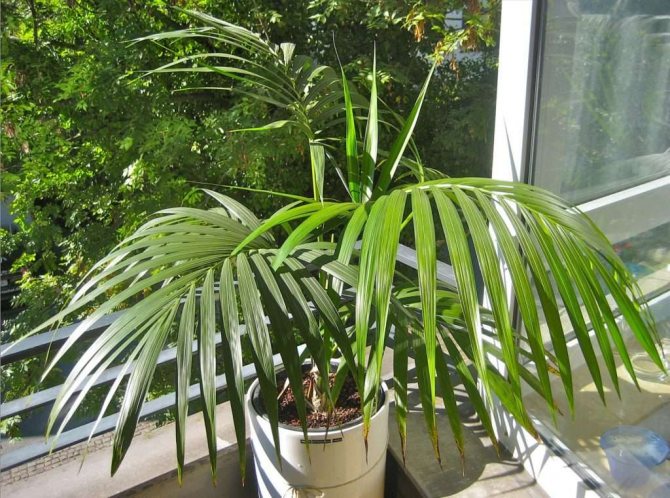

The sand heated in the sun, warm water and palm trees growing on the beach are not even a dream, but a real Paradise on Earth, a piece of which can be transferred to your home. If everything is not so simple with the beach and the sea, then it is absolutely possible to grow an exotic tree in indoor conditions. To do this, you just need to know how the palm tree reproduces, and what nuances should be taken into account when growing it.
For health and freshness


How to rejuvenate a date palm? The renewal of the date palm consists in the constant renewal of the leaves that appear at the top and die off at the bottom. It is necessary to delete withering or withered bottom twigs.
Upper branches can not be cut! This can lead to the death of the plant. Drying of the upper branch is an unnatural process and signals a disease.
To give the plant freshness, the leaves need spray daily... Once a week, you can make abundant watering of the aerial part of the plant, while covering the ground with a film. It is good to wipe the leaves with a damp sponge, this will give the plant freshness and serve as an additional prevention against parasites.
Seed propagation
There are not so few types of palms, and almost all of them are prone to seed propagation, and some exclusively in this way.It is he who is considered the easiest and almost guaranteed to give, albeit far from instantaneous, but the result. The whole process of propagation of palm by seeds begins with their preparation. Planting material can be purchased at a specialty store or on an Internet site, including well-known Chinese platforms for selling cheap goods.
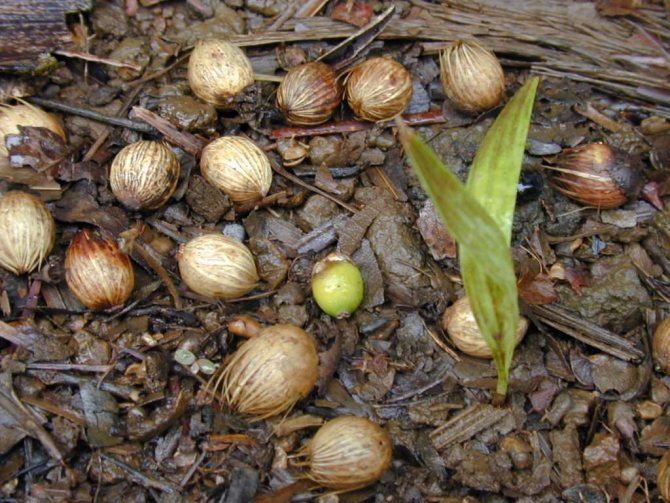

The main thing is not to buy expired goods, and pay attention to the labeling, since the seeds of a palm tree that have been stored for a long time will not germinate with a high degree of probability. The preparation of planting material is as follows:
- the seeds are freed from the outer shell;
- in a purified form, they are immersed in a container with warm water;
- hold there until swelling visible to the naked eye.
It happens that the natural shell is too tough or rough. In this case, it is better to carefully cut it without damaging the inner core of the seed. As for the water, it is advisable to change it from time to time so that the temperature is maintained around 30 degrees Celsius. When the planting material is swollen, it is ready for sowing, for which both ordinary cups or pots and dimensional boxes are suitable. The containers are almost filled to the top with a special substrate consisting of garden soil and sand in a ratio of about 2 to 1.


Seeds are immersed in the upper sandy layer to a depth of about 2-3 cm. The soil is necessarily moistened, but not with a stream of water, but with light spraying, after which the container with seedlings is covered with polyethylene, transparent glass or plastic - this creates a greenhouse effect and maintains moisture acceptable for palms.
The first seedlings will have to wait for a relatively long time - several weeks or even months. It all depends on the quality of the planting material and the type of tropical plant. When the sprouts get a little stronger, they must be transferred to individual containers with the same substrate and rearranged to a well-lit place, which is not exposed to direct sunlight.
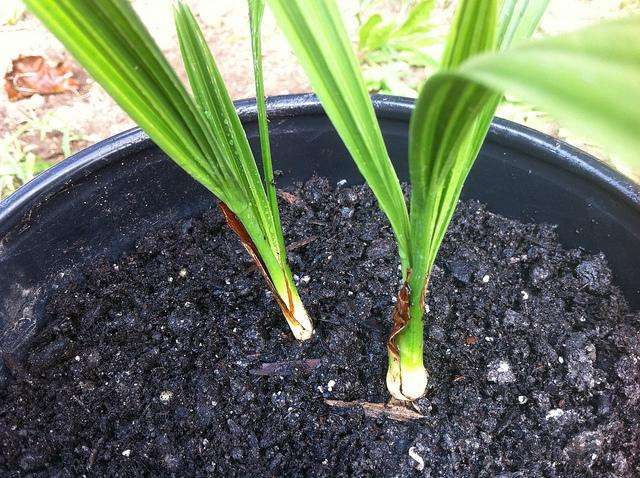

After a month or two, young palms can be completely freed from the film covering and thereby contribute to their adaptation to room conditions. Upon completion, the plants are transplanted into permanent pots.
The main fungal diseases of palm
It is not difficult to care for a home palm tree, but only if the grower knows about the features and needs of a tropical plant. Otherwise, pathogenic fungi - pests that provoke dangerous diseases and pathologies - can "take a fancy" to the palm tree.
Alternaria and dry spot
The causative agents are fungi belonging to the genus Alternaria. First of all, they affect the foliage, less often the stem, tubers can be affected in tuberous tubers.
Signs of the disease: spots on the leaves are brown, dry, with concentric circles. Gradually they turn black, grayish conidia become noticeable.
As a preventive measure, it is recommended to regularly ventilate the room. For treatment, the following fungicidal preparations can be used:
- Abiga peak - 25 g per 5 liters of water.
- Oxyhom - 10 g per 2.5 liters of water.
- Vitaros - 1 ml per 0.5 l of water.
The crown of the tree is sprayed every 1.5 weeks, 2-3 procedures are required.
Anthracnose
Pests - pathogenic fungi that can belong to the following genera: Colletotrichum, Gloeosporium, Kabatiella. It is worth noting that palms and ficuses suffer from their activity more often than other indoor vegetation.
With anthracnose, foliage, petioles, stems are affected, the fungus reaches the fruits.
Symptoms: leaf blades are covered with spots that look different, depending on the type of pathogen. They can be small, round, reddish, brownish, or yellow. In any case, they grow and sometimes have a dark point inside. The higher the humidity, the faster the pathogen spreads.
It is recommended to remove leaves with a modified structure, disinfect the ground before planting and pickle the seeds. Do not irrigate affected palms.
Anthracnose is treated with fungicides:
- Bordeaux liquid 1% - diluted according to the recommendations specified in the instructions.
- Copper sulfate - 10 g per 1 liter of water.
- Colloidal sulfur - 25 g per 5 liters of water.
- Abiga-peak - 25g per 5 liters of water.
Powdery mildew
A common infectious disease that quickly spreads from one indoor flower to another, so even large palm trees can suffer from it. The causative agents of the disease can be fungi from the genera Podosphaera fuliginea, Erysiphe cichoracearum and Oidium.
You can learn about the damage to the plant by the following symptomatology: the leaf blades are covered with small mealy specks that can be erased with your fingers, but they reappear and become larger. Over time, they acquire a rich gray color. The leaves begin to dry, the palm stops growing.
Experienced flower growers advise, during the active growth of flowers, to carry out preventive treatments with sulfur and spraying the crown with milk whey, 3-4 times during the spring and summer. In addition, it is impossible to overfeed palms with nitrogenous compounds, this increases the risks of developing this ailment. But phosphorus and potassium strengthens the green pet, making it more resistant to such fungi.
But, what if, nevertheless, a tropical tree fell ill with powdery mildew? For treatment, the following antifungal agents are used: Chistotsvet, Raek, Skor, the active ingredient of which is difenoconazole or Topaz containing penconazole. 2 ml of the preparation is diluted in 5 l of water and the green part of the plant is treated.
With a small infection, you can cure a palm tree by spraying its foliage with a mixture of soda ash and copper sulfate. It is prepared according to the following algorithm:
- 10 g of soda is dissolved in a liter of water.
- 2 g of shavings of tar or laundry soap is added.
- Water is poured into a glass - 200 ml, 2 g of copper sulfate is added to it.
- Both solutions are combined and water is added to a volume of 2 liters.
- A sick specimen is sprayed with the remedy.
It is useless to use antibiotics for the treatment of fungal diseases, the drugs of this group are ineffective in this case. Bordeaux liquid also helps with powdery mildew.


Gray rot
If it is damp in a pot with a palm tree, and the weather is hot, then you can expect the appearance of a gray-olive bloom on the plant with the edge. The culprit of the disease is a fungus from the genus Botrytis. Initially, the stem is affected, and later - foliage, flowers, fruits.
Gradually, the affected areas become dry rot-like, covered with concentric spots. The spots increase in size and ring the stem. Gray mold resembles a layer of mold and loose cotton bloom.
You can prevent the development of the disease if you adhere to the basic rules:
- The soil should be disinfected before use - warmed up in an oven or microwave.
- Ventilate the room regularly.
- Remove dying foliage.
- Provide the palm tree with abundant lighting.
When transplanting a tree, it is recommended to spill the soil with solutions of special preparations - Trichodermin, Barrier, Zaslon or Fitosporin. If the plant is affected by gray rot, then complex therapy is required, consisting of a number of measures:
- The affected leaves are removed.
- Slices are sprinkled with charcoal or ash.
- Damaged areas can be lubricated with a paste of Trichodermine - the powder is mixed with a little water.
- It is recommended to spray the crown with special agents - 0.1% Topsin-M or Fitosporin, diluted to the color of tea leaves.
The following preparations also help against gray rot - 0.2% Fundazole solution, a mixture of 0.2% copper sulfate and 2% laundry soap, Chistotsvet, Skor, Raek. As a rule, repeated treatments are required, which are carried out after a week.
These are not all diseases caused by fungi and the owner of the exotic should carefully monitor the condition of the pet. In addition, palm trees can also suffer from insect pests.
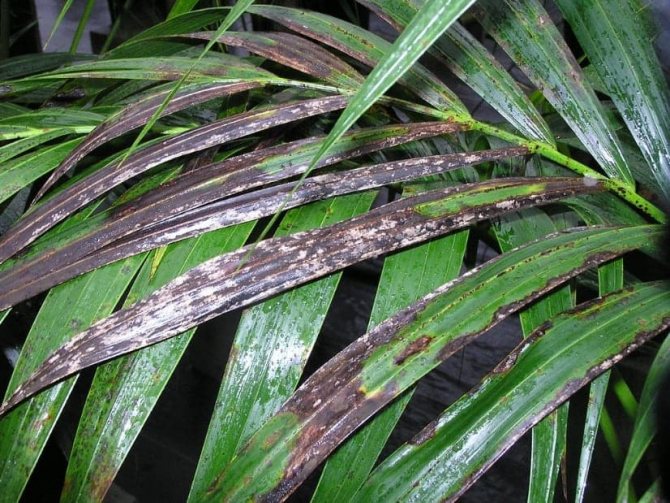

Vegetative propagation
Many tropical plant lovers are wondering how to propagate a palm tree at home without using seeds. The fact is that the overwhelming majority of these tropical inhabitants are not prone to branching and form only one stem. Fortunately, there are exceptions that go beyond the rules - bush palms, which include hamerops, chrysalidocarpus, hamedorea and some others. They can be propagated by root suckers.
Offspring
To identify the offspring, it is necessary to examine the roots of an existing palm tree. As a rule, in adult plants, such processes are located at a minimum distance from the topsoil. Emerging from the roots, they protrude somewhat away from the mother plant and eventually take root in the ground. It is necessary to wait for the moment when one or more offspring will put down thin roots and go a little deeper.


After that, they must be carefully cut off with a sharp knife, and sprinkle with ash. The removed part of the palm tree is transferred to a container with a moistened substrate and, as in the case of propagation by seeds, a greenhouse effect is provided to it. Over time, the offspring takes root in a new place and forms a full-fledged plant.
Tops
This method is not acceptable for most palms, but the same yucca or dracaena are easily amenable to this type of reproduction. To do this, it is necessary to separate the strong, healthy top of the plant. A sharp knife or a compact garden hacksaw will do this. The cut off stem is immersed in the substrate so that the leaves are on top. If you dig them, the process of decay will begin.


As for the soil, then its composition should include:
Soil mix
The palm tree reproduces best in light, fertile substrates. For this culture, the following mixture is often made:
- 1 volume of coarse sand;
- 1 volume of fertile soil;
- 2 volumes of good humus.
River sand works best. At the bottom of the container, you need to pour a drainage layer of fragments of red brick, since excess moisture can cause rotting of the root system.
There is little sunlight in the room facing north. In this case, it is advisable to install the tree right next to the window, creating a background for it of light curtains that additionally reflect light.
In the early years, the leaves of young palms differ from those of adult plants, they are very delicate. Caring for grown plants is no different from caring for adult palms.
Palm care and how it reproduces depends on the type of plant. Some types of palms reproduce only by seeds, some can be propagated by division or daughter offspring. Adhering to these tips, growing a beautiful palm tree will be easy even for an inexperienced grower.
How to propagate a palm tree
How to propagate a real palm tree?
For palms, as for many indoor plants, seed and vegetative propagation is characteristic. Most palms grow in one trunk and have only one point of growth - at the top.
Important! If you cut off the top of a palm tree, it dies.
Thus, for a palm tree among vegetative methods, the following are acceptable:
- deposition of basal offspring formed from the buds on the roots;
- separation of lateral pagons for those plants that have the property of forming them at the base of the trunk.
However, there are species in which neither lateral shoots nor root shoots grow, and the only way to reproduce them is by seed. These plants are considered:
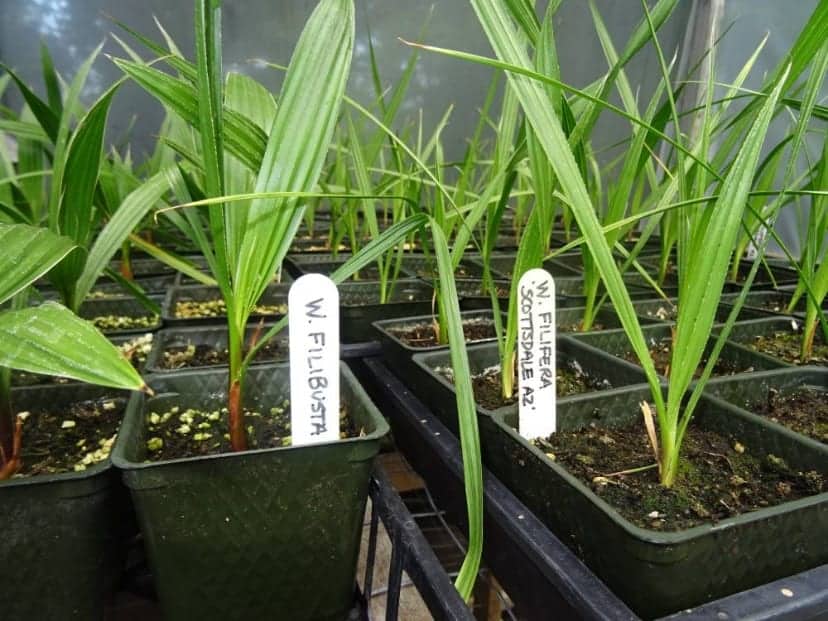

Heterosporosis and phyllostictosis
Heterosporosis is treated in the same way as in the case of Alternaria.True, the symptoms of this disease are somewhat different. The spots on the affected dracaena are oblong, light beige in color and reddish edging. Over time, a green plaque appears on the diseased areas - the result of the release of fungal spores.
Phylostictosis is another fungal disease of dracaena, which is most often observed in mature and "elderly" plants when the moisture regime is disturbed. At the same time, the spots have a yellow-green border and a beige main shade, an irregular shape. Small black dots can be found in the middle. Again, the salvation is in fungicides.
Vegetative propagation of the present palm
Chrysalidocarpus yellowish, chamedorea, date palm, as well as other bushy palms - karyota, high rapeseed, chamerops are propagated by root offspring.
During transplantation, root suckers are separated and transplanted into separate flower containers filled with light soil mixture for young palms. However, for cutting off from the mother plant, only those shoots that have already formed a completely viable root system are suitable. Places of cuts on the roots of both an adult palm tree and the offspring are sprinkled with charcoal powder for disinfection.
In palms that have the ability to branch at the base, side shoots are separated and planted for rooting in a nutritious soil mixture. It consists of 1 part of leafy humus and 2 parts of sod land with the addition of 1 part of sand. Young palms are regularly moistened and sprayed. The fact that they have successfully taken root is evidenced by the new leaves that appeared on the top of the plants.
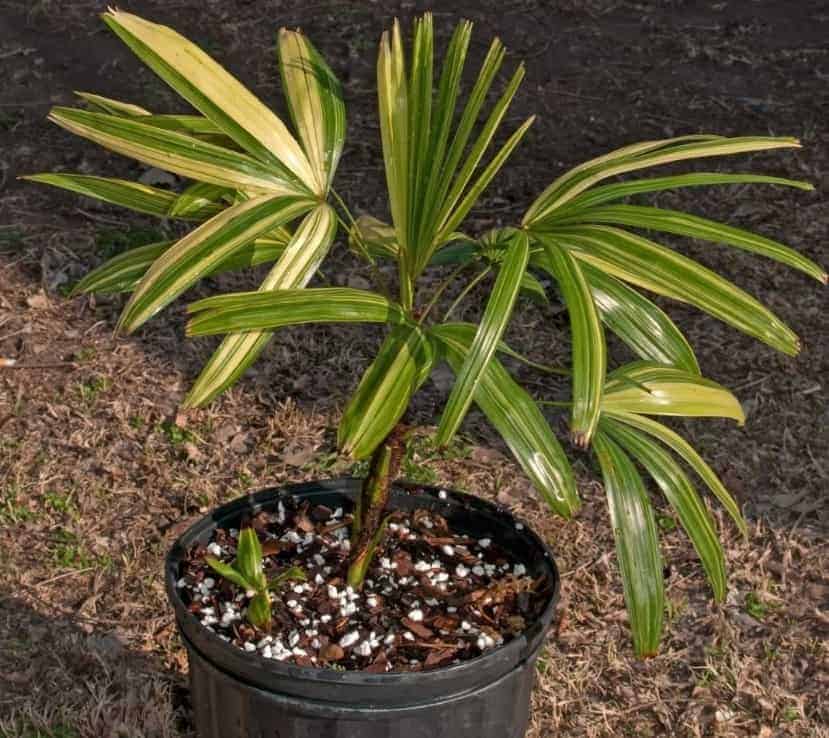

Bacteriosis
Bacteriosis is an incurable disease that can develop in dracaena due to waterlogging of the soil, dampness, heat, lack of air and an unsuitable substrate with a high alkali content. Of course, these factors by themselves are not capable of causing illness, but they weaken the flower, and it becomes defenseless against any attacks from the outside. So, the main signs of bacteriosis include:
- Darkening and wateriness of the tips of the leaves;
- The formation of brown rotting areas on the leaves, damp to the touch. When dry, a film remains on the surface;
- Small round ulcers on the stem and petioles;
- Wide yellow stripes separating the affected part of the leaf and the healthy one.
Infected dracaena poses a danger to other green inhabitants of the room. Therefore, the diseased flower will have to be destroyed in order to avoid the spread of the infection.
Another ailment that does not respond to treatment is spotted wilting. The leaves of the flower are covered with specks without a definite shape and with longitudinal brown stripes. The growth and development of the plant is sharply inhibited, new leaves grow weak and ideally formed. No drugs have yet been invented for this virus.
Sowing the seeds of a real palm
The seed method is much more troublesome than the vegetative one, but, unfortunately, some types of palms cannot be obtained in other ways, except by growing from seeds. Their germination is lost very quickly. Fresh planting material germinates no longer than a month, seeds that have been stored for several years - up to 3-4 months, will sprout in 2-4 months.
On the eve of sowing, the planting material must be prepared, since the hard shell covering the seeds makes it difficult for seedlings to germinate. It is lightly filed with a nail file so as not to disturb the contents inside. Alternatively, the seeds are immersed in warm water (approximately 30–35 degrees) for several days and placed on a windowsill with a radiator at the bottom.
Prepared seeds are embedded shallowly in a mixture of sand and chopped sphagnum moss or in clean sand. Top crops are covered with plastic wrap and kept at a temperature corresponding to a particular type of palm. For most of them living in temperate regions, it is 20-22 degrees, for plants native to the subtropics - 28-30 degrees above zero.
The soil is regularly watered so that it does not dry out too quickly, mulch with a thin layer of moss. The first shoots will appear only after a few months. They are moistened daily with soft water at room temperature, not lower.
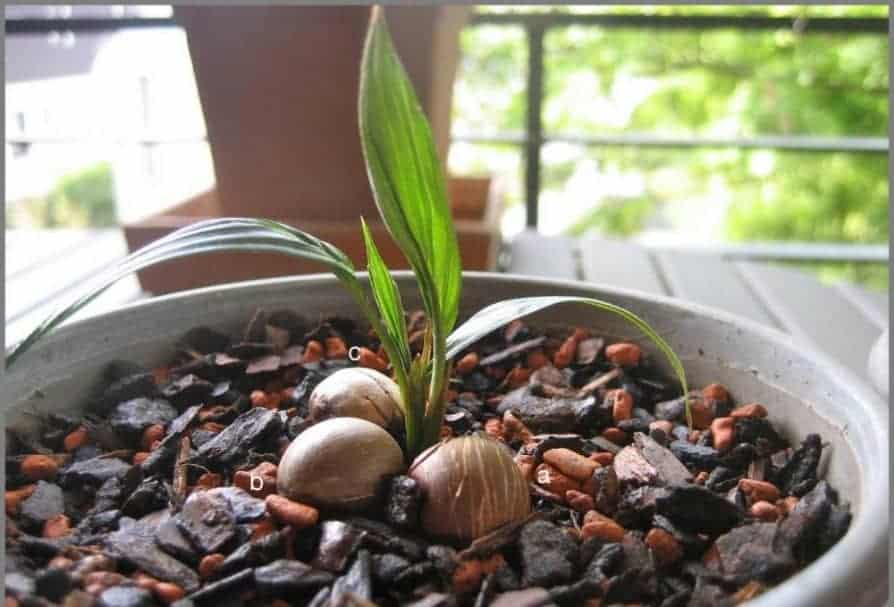

When the first leaves of the seedlings grow and become at least 8-10 cm long, they are transplanted into separate flower containers with a diameter of 9 cm. The pots are filled with a substrate of the following components:
- sod land - 3 volumes;
- humus - 2 volumes;
- sand - 1 volume;
- leaf land - 2 volumes.
Diseases of palm trees caused by improper care
A tropical beauty is extremely sensitive to any changes in the external environment and requires maintaining an appropriate microclimate for it. Neglect of the basic rules of care for a long time causes physiological diseases of dracaena, which outwardly manifest themselves as negative changes in the appearance of the leaves. How to recognize a problem and identify its cause?
- Yellowing of young leaves - lack of moisture, the beginning of drying out of the plant;
- Falling green leaves - constant drafts, long stay at temperatures below 16 degrees, excessive and frequent watering, stagnation of liquid in plant tissues;
- Drying of the tips of the leaves - very dry air in the room, staying in the immediate vicinity of heating appliances;
- Pale color of leaves, loss of rich green hue - lack of light;
- Wrinkled and lethargic leaves - freezing, lack of heat.
In most cases, dracaena diseases are caused by the fact that the flower is in inappropriate conditions. The most common maintenance mistakes are the wrong watering regime, placing the pot in an open draft, and choosing the wrong soil.
Therefore, beginners in floriculture are strongly advised to familiarize themselves with all the points of care for dracaena.
So, in relation to the plant, overflow or, on the contrary, "dry" maintenance, placing it in cold rooms with drafts is not allowed. The correct selection of soil is of great importance: it should be light, airy, it is good to pass moisture and air, it should not contain peat, since it retains water. In addition, do not overuse feeding;
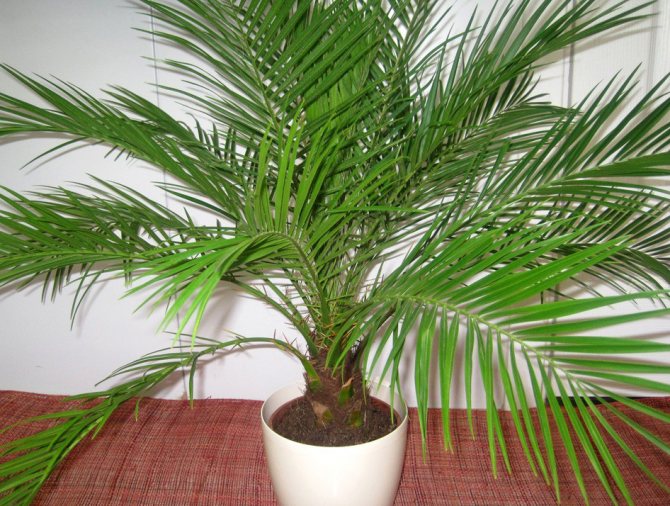

If the rules for keeping palm trees are not followed, various spots are formed on the leaves, drying out of the tips and wilting of a physiological nature.
- Brown spots - with excess moisture, too hard water for irrigation and a sharp drop in temperature.
- The lower leaves turn brown - this is natural aging. Old leaves darken and die off - they are simply cut off.
- Brown leaf tips - formed when the air is too dry, lack of moisture in the soil or low temperature. Make sure that in winter the palm tree does not stand on a bare windowsill and does not come into contact with the glass with leaves. Place a piece of styrofoam under the pot.
- Rounded spots with a brownish halo are formed when the leaves are burned. Do not put the palm tree directly in the open sun in summer. Train the plant to the sun gradually and, if possible, cover it from the scorching rays.
- Pale leaves - spider mite damage is possible.
How to propagate false palms and palm-like plants?
The group of plants resembling palm trees includes such a variety of species that it is extremely difficult to generalize their methods of reproduction. All of them grow from seeds, many reproduce by cuttings - apical and stem, as well as air layers and root shoots. More often than others, under the name of palm trees, yucca and dracaena are grown at home, which are easy to cut and take root even without additional auxiliary procedures.
Propagation of false palms by cuttings - apical and stem
Very often, the long leafless trunk of a dracaena or yucca with a small bunch of leaves at the top looks slightly decorative. In such cases, flower growers rejuvenate the plants by cutting them “to the stump” - about 5–8 cm above the level of the earthen coma.Very soon, young shoots with beautiful foliage grow on the side of the hemp remaining in the pot.
The cut part is divided into 20–25 cm pieces, and the top is rooted separately. The cuttings are buried in a peat-sand mixture and moistened regularly. A semblance of a mini-greenhouse is erected on top, covered with plastic wrap or glass. Periodically ventilate and make sure that condensation does not accumulate or mold does not appear on the soil mixture.
Usually, cuttings release roots within 3-4 weeks and form lateral rosettes of leaves. The emergence of new young leaves testifies to the rooting of the apex. They are transplanted into separate containers filled with a substrate for adult specimens when the roots reach at least 5-8 cm in size.
In plants that form root shoots, the offspring are separated during transplantation, taking the necessary precautions against the appearance of various infections - fungal or bacterial.
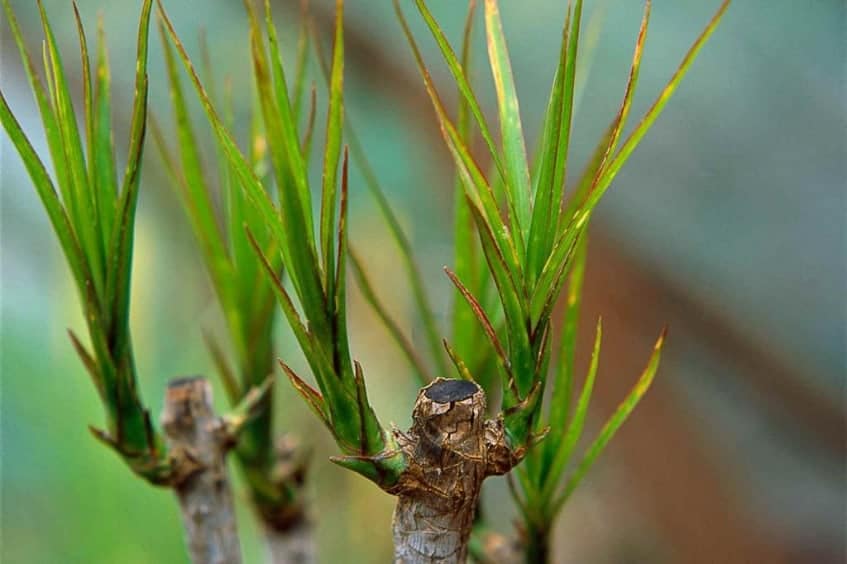

Seed method of propagation of false palms
Most palm-like plants are grown from seeds, following the general sowing rules: they are buried in a peat-sand mixture and covered with cellophane wrap on top to create greenhouse conditions.
However, the conditions for keeping bowls with seedlings are different. For some, heating of the soil mixture is required, and they are placed on a warm windowsill, while others germinate at moderate temperatures. The level of illumination is also different and not all plants play a significant role in the emergence of seedlings. Common to all crops is regular moistening of the soil mixture and constant airing of the mini-greenhouse. Some seedlings require picking, plants with large seeds do not need such a procedure - they are initially planted at the required distance from each other.
The composition of the soil mixture into which the seedlings are transplanted is also distinctive. Among plants similar to palm trees, there are succulents that do not need very fertile soil and a generous proportion of sand in the substrate is important. False palms belonging to different families require different growing conditions from seed.
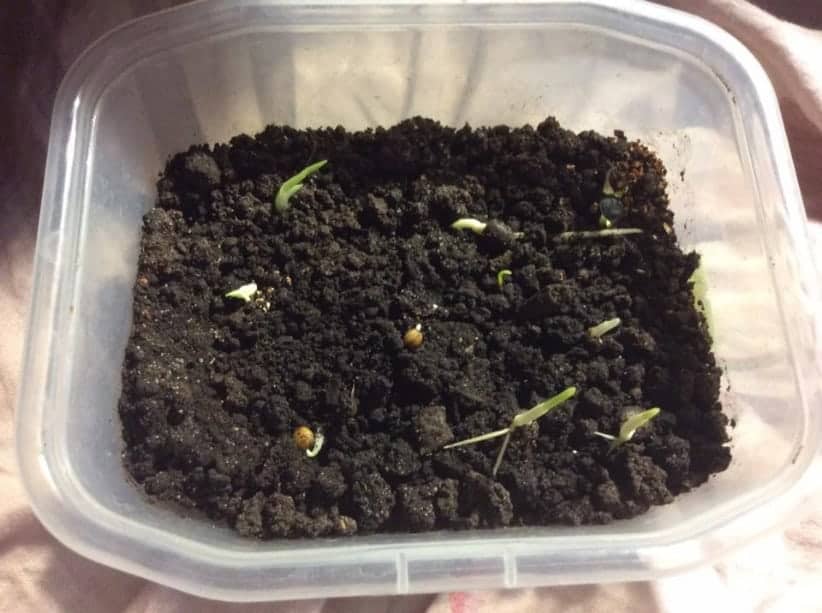

Family of palm plants
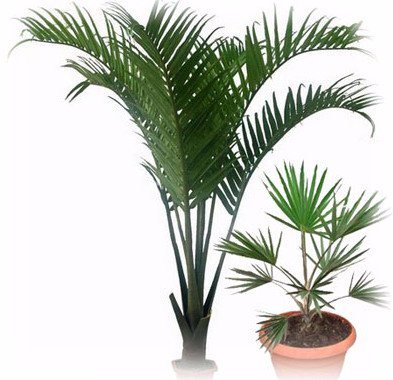

The most common place to see a palm tree is in tropical or subtropical areas. Also, they are always grown in botanical gardens, while creating the most optimal conditions. But, despite the fact that palm trees can grow to gigantic sizes and are demanding on high air humidity, many members of the palm family were able to adapt to growing in urban apartments.
The main feature of palm trees is their slow growth, due to which even in 20 years in your tub it is unlikely to rise higher than 2 meters, which is quite acceptable for the height of the apartment. Among the many varieties of palm trees that are suitable for home cultivation, two varieties stand out:
- Pinnate palms.
- Palms are fan-leaved.
Photo gallery
What a date palm looks like and how it blooms: photo and description of the tree at the time of flowering
Peduncles of a palm tree emerge from the axils of the leaves. They visually resemble an open saber, are combined into paniculate inflorescences. Each flower also has 3 petals. They are small in size. A feature of the flowering of the date palm tree is dioeciousness. One plant contains both male and female flowers. Moreover, the former are much smaller, but collected in denser and straightened inflorescences. They are cream-colored. Each has 6 stamens. The second ones are colored yellow. They are distinguished by luxurious splendor, they look stronger, they sag due to the weight of the fruits that arise in them.
How the date palm blooms, look at the photos below:
Common varieties of homemade hamedorei
- The most common chamedorea elegance is a palm tree with a bare trunk and dark green leaves. Its flowering is interesting - branches covered with yellow balls.
- Hamedorea high is so named for a reason, it reaches 2 meters in height and is not a bushy palm tree. The flowers of this plant are orange.
- The favorite of flower growers is chamedorea monochromatic with light leaves and yellow flowers.
- The Arenberg variety is a rare species. This palm has a single trunk with 5-6 wide leaves.
- Another valuable tree is Ernesta Augusta - luxurious, with green hair.
- The metallic variety belongs to the unpretentious and shade-tolerant indoor palms. The plant is considered one of the ideal options for the home - it grows no more than 2 meters, remains green throughout the year, retains a dense crown. It blooms at an early age with orange-red flowers - small, reminiscent of shaggy panicles. They can hardly be called beautiful, but they smell very nice.
Whichever hamedorea you choose, they are all amazing. Or maybe you have rare varieties? Then you can be envied in an amicable way.
Typical problems


The main problems in the cultivation of the date palm are related with a lack of certain nutrients.
- The leaves turned light green and the plant stopped growing - it lacks nitrogen.
- Bronze spots appeared on the leaves, over time, necrosis of the edges appears, the leaf dries up and curls - the plant needs potassium.
- With a lack of magnesium, a light yellow stripe appears along the edge of the leaves, and the center remains bright green.
- The leaf develops poorly, signs of chlorosis and large necrotic stripes appear - an obvious lack of manganese.
Photo gallery
A bunch of ripe dates can weigh about 25 kg. The fruits are widely used for the preparation of sweet treats, have a laxative effect. They also make up more than half of the diet of the population of the countries where palm trees are grown.
Landing in open ground
You can plant a palm tree on a site only when it is warm enough outside and with a minimum probability of frost return. Landing in open ground begins with choosing a site. It should be well lit. If possible, it is advisable to choose a site where there are no tall trees. It is better that the place is protected from drafts. It is recommended to treat the soil with special agents that prevent the appearance of weeds. The soil must be loose.
Seeds
Seeds can be planted directly into the ground. This is done only after the planting material has been scarified and treated with growth stimulants. As soon as the seeds are ready, you should start preparing the holes. The pits should not be too deep, but it is not recommended to plant seeds practically on the surface.
The holes must be made at a distance of 60-80 centimeters from each other. If there are a lot of seeds, you need to spread 2-3 grains in each hole. This will increase the likelihood of seedlings emerging. No matter how ideal growing conditions are, sprouts will appear at best in a few months. Then it will be necessary to clean up the plants. What is meant? Several seeds will sprout in one hole at once, and you will need to leave only one sprout, removing the rest. Growing a palm tree in a seedless way is not laborious, but a lengthy process, since you will have to wait a long time for seedlings to appear, and even longer until the palm tree itself grows.
Scion
Planting an offshoot in open ground is the best option and, perhaps, the easiest. The roots of the plant are strong, but during the planting process, caution will not hurt. First of all, you should make a hole of a suitable size: it should be about twice the size of the root system of the appendix. A young plant is placed in a hole so that the ground level is 2-3 centimeters above the roots. The hole is covered with soil and compacted. Then all the holes should be watered abundantly. In order for the soil to always retain moisture, it is recommended to mulch it, for example, with sawdust.Thanks to this, the palm tree will not be disturbed by weeds.
Mature tree
Planting a mature tree is not easy, but possible. The root ball of the plant is measured immediately, and only then a hole is dug. It should be 15 centimeters deeper than the roots of the palm tree and 15 centimeters wider in circumference than the root system of the plant. The result is a moderately deep hole.
The wrapper is removed from the roots of the palm tree, they are straightened. After that, you need to place the tree in the hole. The top of the root ball should be slightly below ground level (2 to 2.5 centimeters). The palm must be aligned. After that, the pit is covered with earth, or it is possible with sand-based gypsum plaster. The plant is watered, backwaters are made. Don't forget the mulch!
Photo gallery
White bloom due to mealybug
The appearance of a white bloom on dracaena signals the defeat of such pests as mealybug, spider mite or scale insect. It is very important to make a correct diagnosis here, because depending on the root cause, the methods for removing plaque will be different.
The mealybug reveals its presence by the appearance of cotton-like patches on parts of the plant - this is how hordes of multiplying parasites look like. It is necessary to take immediate measures - to collect insects with cotton wool soaked in soapy water. Use the remaining solution to wipe the window sill and the pot where the flower was contained. Dracaena should be thoroughly rinsed in the shower.
Finally, the plant transplanted into a clean container and fresh soil should be sprayed with a composition of laundry soap and alcohol in a ratio of 1-2 g per glass of vodka. Or use any insecticidal drug like actellik. It is advisable to spray it several times with a break of 3-4 days in order to surely destroy all insects without leaving a residue.
Transfer method
Algorithm of actions
Palm roots are incredibly sensitive to growing conditions and any kind of injury. Carelessness will necessarily lead to the discarding of leaves and the death of the yucca. How to properly transplant so that the plant quickly comes to life? A gentle method should be used - transshipment, that is, partial preservation of the earthen clod around the roots.
The process is simple, it is important to follow a series of simple steps step by step:
- choose the right pot - 2-3 cm wider than the previous one;
- organize a drainage layer (3.5-4 cm);
- cover the drainage with a layer of fresh earth (up to 2 cm);
- place a yucca with a native earthen lump inside the pot;
- fill the remaining voids with new nutrient soil.
It remains to choose a place for the plant with diffused light and no drafts. Acceptable air temperature in the range of 20-25 degrees Celsius.
On a note! It is forbidden to feed the plant with fertilizers immediately after transplanting!
Drainage
The false palm does not tolerate stagnant water. The roots immediately rot, causing disease and death of the yucca. The presence at the bottom of the pot of any inert material for the plant is no less important than the correct composition of the soil.
The following are used as drainage:
- fractions of expanded clay;
- gravel;
- pieces of foam;
- broken brick;
- coarse sand.
Drainage is not used in transport pots. Excess water flows out through many holes located at the bottom. This fact should be considered when watering the yucca immediately after purchase.
Soil composition
The easiest way is to buy a ready-made mixture in a store. The assortment is wide enough. You should choose formulations for palms, cacti or ficuses.
If the house has sand, a universal substrate, turf and leafy soil, you can prepare the mixture yourself, keeping to the following proportions.
| Components | ratio |
| universal substrate + sand | 7:3 |
| leaf land + turf land + sand + compost | 2:2:2:1 |
| leaf land + turf land + sand | 2:3:2 |
Watering
The main task after transshipment of yucca is not to overmoisten the soil in order to avoid decay of injured roots.... It is more expedient not to top up the land than to swamp.It is better to compensate for the moisture deficit in the soil by additional air humidification. Then the yucca will more easily endure the change of scenery.
Family and growing area
The date palm belongs to the Palm family, which includes more than 20 species that naturally grow in Africa and Eurasia (it grows only on arable land). In nature, it is a tree or shrub with large feathery leaves.... It is for these decorative leaves that lovers of indoor plants appreciate it so highly.
Along with different types of plants of the Palm family, decorative deciduous plants, as well as decorative flowering plants, cacti, bulbs and succulents are famous and popular among flower growers. In each of these sections of the site you will find a lot of useful information about a wide variety of indoor plants.
Description
Nowadays, people are increasingly wondering how to plant a palm tree. This is not surprising at all, because the plant is a great addition to the indoor interior and home landscape. Some palms serve only as a decorative function, while others can also be used to harvest delicious fruits. The plant is planted both at home and in open ground on the site. The main thing is to decide on the type of palm tree. There are certain rules for planting a plant, as well as features of caring for it. Compliance with the recommendations will guarantee that you will be able to grow a beautiful palm tree that will delight the eye.
Robelena date palm
The Robelena date palm is a small plant that grows up to a maximum of 2 m. The culture is very compact, therefore it is appreciated by florists as decorative. It is convenient to grow it at home and in greenhouse conditions. In the wild, it is found in the tropical part of India, Burma, Laos as one of the inhabitants of humid forests.
A tree can have one or several trunks at the same time. They have a scaly appearance, since the remains of leaf petioles are located on their surface.
Please note: the date palm of the Robelen species is presented in all its glory in the photo:
How to prevent transplant shock
When a palm tree is transplanted from one place to another, it is much more injured than when transplanting from a pot to the ground. When you move the tree out of the pot, you can simply take it out and put it in the ground without damaging the roots. Expect your palm tree to receive a so-called "transplant shock". Transplant shock occurs when the palm is subjected to various stresses while moving. These stresses arise from new soil, sun rays, new temperatures, etc. To avoid them, you need to perform certain actions.
- Step 1. Removing the leaves. To retain water in transplanted palms, many remove half or two-thirds of the old palm leaves. Some people remove all the leaves. As practice shows, leaving some leaves on a palm tree significantly improves their growth and survival.
- Step 2. Regulation of humidity. When palm trees are pruned, they can suffer from a lack of water. Before you dig up the plant, water it well and wait until the water is completely absorbed and the ground is dry. Then you can moisten the hole in which you are going to plant the tree.
- Step 3. Tying the leaves. Before lifting the palm, join the leaves together to prevent damage. Thin trees can crack easily. To avoid this, tie two sticks to the trunk on opposite sides.
- Step 4. Raising the palm tree. You need to be careful when using a special tree-lifting technique. The bark can be easily damaged and damaged areas make the plant vulnerable to insects and fungi, never attach chain, ropes or cables directly to the trunk. Wrap nylon slings around the barrel and then attach them to the faucet.
- Step 5. Planting a palm tree.Try to plant the tree as soon as possible after you have dug it out. If you cannot immediately place the plant in a new place, then constantly make sure that the roots are moist. The palm should be planted at the same depth at which it grew earlier. Planting deep can lead to water shortages and nutrient deficiencies. Planting too high is also not suitable as the roots are not yet firm and the wind can hit the tree.
- Step 6. Untie the leaves. Recent research suggests that keeping the leaves tied will not improve growth, but may provide a conducive environment for disease. Experts strongly recommend that you untie the palm leaves immediately after planting.
- Step 7. Fertilization. Don't fertilize the palm until you see new growth. No fertilization is needed until the tree has a new root system. After about two months after transplanting, you can start using slow-acting fertilizers.
After transplanting, the tree will take a little time to form a new root system. It will suffer from water scarcity and a frequent irrigation schedule must be established. Water the palm tree every 2 days for 2-3 weeks, after which you can go to your regular schedule.
Don't worry about shock to your plant. The palm tree must get used to the new location and form new roots.
Acclimatization and adaptation can take up to 4 months. All you can do is speed up this process by following the steps indicated.
Forest date palm
The forest date palm is a wild tree found in eastern India. The plant prefers dry areas, lowlands, and river valleys.
The slender and straight barrel has the following dimensions:
- the maximum height that it can reach is 12 m;
- the diameter can vary from 0.6 to 1 m.


The top is topped with 150-200 leaves that have an arched bend and a feathery appearance. Each sheet is approximately 4 m long.
They consist of segments:
- about 35 cm long;
- 4 to 5 cm wide.
Leaf-like segments are combined into groups: in each - 3-4 pcs. The leaves are painted green with a gray-gray tint.
The length of the petioles on the leaves is 1 m. As expected, according to the general description of the plant, thorns 3-15 cm long grow on their lateral parts. The bases of the petioles are distinguished by a brown fibrous coating. The inflorescence is atypical for most palms - it is not hanging, but, on the contrary, is directed upwards. The length of the inflorescences is slightly less than 1 m.
What a forest date palm looks like is clearly shown in the photo:
Photo gallery
Photo gallery
The images show that the inflorescences are very short compared to other plant species - their length does not exceed 35 cm.
Choosing a location and lighting for a palm tree
In the question of how to care for a palm tree, first of all, it is worth providing the plant with the correct growth site and lighting. It is good if scattered natural light constantly falls on the palm tree during the day. It is especially important that it enters the room from both the south and the west, so that the plant is illuminated from 11 am to 4 pm. In the summer, there must be tulle on the window, since many types and varieties of palm trees do not tolerate direct sunlight. But in winter, palm trees can be placed without fear even on the windowsill (if it fits there), since such a light cannot burn the leaves.
Why does the plant dry out after transplanting
The most common question that arises among novice growers: why does the palm tree dry after transplanting? There are several explanations for this.
If the recommendations were not followed during the transshipment of the root system, the palm tree may die.


The reasons for this phenomenon:
Top dressing
- Before fertilizing, the soil is watered with clean water.
- After transplanting, fertilizers are applied on day 14.
- During the period of active growth, organic fertilizers are required. You can use manure for this. Infuse it for 10 days with the addition of liquid, then strain. Dilute the resulting infusion 1: 5 with water, if the cow component was taken as the basis, 1:10, when using chicken manure.
- Further, the bushes are fed with mineral fertilizers (once every 14 days), which can be purchased at the store.
- Do not use fertilizers during dormancy (November-March).
- Also, the palm tree loves foliar feeding. It is enough to take them once a month using urea.
How to transplant correctly at home
The young shoot is delivered to the flower shop with a peat substrate.
In nurseries, plants are supplied with fertilizer, therefore, when at home, peat quickly deteriorates. The plant owner needs to transplant the palm tree as soon as possible.
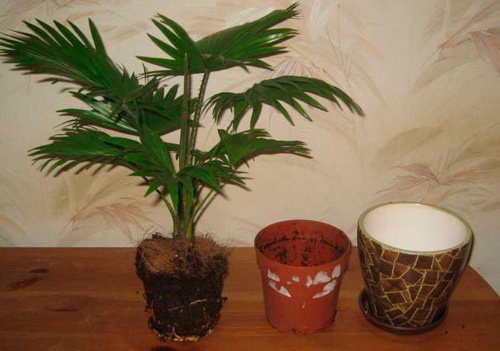

Consider how to correctly transplant a plantation step by step:
| Stage | Description |
| Preparation | A palm tree with a root system is pulled out of the past pot and placed in a basin of warm water, where 0.5 grams of potassium permanganate is diluted in 10 liters of water |
| Soil preparation | When the previous soil or peat softens, the root system must be slightly freed from the substrate and transplanted. |
To do this, prepare the soil: sand, gray soil and black soil in equal amounts. You can also purchase ready-made soil for palm trees.
Before laying expanded clay drainage, it must be calcined in the oven to disinfect it. A detailed video will help you carry out the transplant correctly
Planting material
The palm tree can be planted in two ways: seedling and seedling. The first method involves planting seeds directly into open ground or a pot. The second method is sowing seeds, growing seedlings and then transplanting the shoots to a permanent place, which can be either a garden on the site or a home greenhouse.
Having planted the seeds in open ground, you will have to wait a long time for the palm tree to stretch out. For this reason, flower growers recommend opting for the seedling method. It is more reliable, since the planting material, in the case of growing shoots, will be guaranteed proper care. The seedlings will be more robust, and therefore the likelihood that a healthy palm tree will grow is still higher.
In any case, whichever method is chosen, the seeds should be prepared. I must say that the seed of a palm tree has a rather hard shell, which, in fact, slows down the germination of seedlings. For this it is necessary to carry out scarification, that is, to violate the integrity of the seed shell. This can be done in several ways, for example, thermally or mechanically.
Heat treatment of seeds involves the following actions:
- take two containers, pour hot water into one and cold water into the other;
- put the planting material in a cloth bag;
- dip the bag alternately in hot and cold water, holding it in each container for 10-20 seconds;
- after several manipulations, check if the shell has begun to crack;
- stop scarification when the bone shell cracks.
The mechanical method is easier, but much more dangerous, because you can overdo it and the seeds will be spoiled. You will need either a regular knife or sandpaper. The seeds must be cut, rubbed with paper so that the shell cracks a little. It is very important to preserve the protective shell, but make sure that the seed can sprout.
After scarification, the seeds must be treated with growth stimulants.For these purposes "Dratsen", "Gibberellin", "Energen", "Epin Extra", "Humat Baikal" are suitable. They must be used strictly according to the instructions on the package.
Then the seeds can be planted in prepared soil. The treated planting material is suitable for outdoor planting if the weather conditions are appropriate.
To grow seedlings, you must also prepare the soil. For sowing seeds, just leafy soil is suitable. It can be supplemented with peat or sawdust. The combination of these components is ideal for planting palm seeds for seedlings. It is equally important to choose the right containers. The optimal height of the pots is 15 centimeters. It is better to plant seeds for seedlings at the end of winter.
Then follow the step-by-step instructions:
- In the bottom of the containers, make through holes through which excess water will come out.
- Place drainage at the bottom of the pots. Large pebbles or chipped bricks are what you need.
- Fill in prepared soil.
- Plant the seeds 2 to 3 centimeters deep, keeping a minimum seed spacing of 4 centimeters.
- Cover the containers with plastic wrap or glass.
Seedlings are easy to care for. It is important that the required temperature regime is maintained in the room, which is different for tropical and subtropical palms. The germination temperature of seeds for tropical species is 28-30 degrees above zero, while for subtropical species it is 22-25 degrees above zero. It is imperative that daily watering is required, but only in portions, without flooding the ground in order to avoid stagnant moisture.
Pure luck if the first shoots appear in a month. This is extremely rare. In most cases, the sprouts will hatch after several months (from 2 to 4, depending on the variety and care). When the seedlings grow by 10-15 centimeters, you can proceed to transplanting them to the main place.
Pests and diseases
- Root rot. Symptoms: yellowing of the leaves, followed by the death of the flower. The reason is overflow and temperature changes. As a result, the disease is exacerbated.
- Rot of the stems. Signs: dark wet spots appear on the leaves. Sometimes it can be gray spots with a light coating. This fungal disease develops from high humidity and overflow. The disease develops very rapidly, so the bush should be saved as soon as possible when the first signs appear.
- Penicillosis. Young leaves are exposed to the disease with the appearance of necrotic dried specks on them. The leaves are deformed. Improper care is the cause of the disease.
- Leaf spot. The disease is caused by bacteria and pathogenic fungi. Symptoms: spots of various shapes and colors appear. Humidity is a favorable environment for its development.
How to fight
- Root rot. You can save the plant at the initial stage of the disease. The bush should be pulled out of the ground and the affected roots should be cut off. Then, for 15-20 minutes, dip in the fungicide solution. It is desirable that the preparation contains cinebaftin, cuprozan and homecin. Treat cut areas with activated carbon and replace the soil. If the soil is prepared at home, you need to warm it up in the oven or steam it. Carry out two waterings with fungicide.
- Rot of the stems. Adjust humidity and watering. Remove all affected leaves, and transplant the flower into new soil with fungicide treatment. When the disease is neglected, the plant is destroyed.
- Penicillosis. Adjust light and temperature conditions.
- Leaf spot. At the first sign, trim off infected leaves and spray with a fungicide. The interval between treatments is 14 days.
Humidity and air temperature
The palm tree, like all exotic plants, loves very warm rooms. The average daily temperature should be at least 23 degrees.It will be even better if you can maintain 30C, but for a living room this is too much, suitable only for a specialized greenhouse or living area with separate heating. The tree does not like drafts, therefore, even at a relatively high temperature, it can die.
Sudden changes in temperature are very dangerous for the plant. Cold air indoors in winter is a great danger. If you open the window for a few minutes, the palm tree can die immediately if the cold outside air hits it. Low air humidity is especially bad for the health of an exotic species.
The leaves dry out, lose their natural color, and sometimes fall off. If you cannot maintain a constant humidity of 85-90%, you will have to spray the leaves regularly, preferably 2-3 times a day. For small rooms, it is important to supply an autonomous air humidifier. Then it will be possible to leave the greenhouse for a long time without constant maintenance.
- Palm trees love high humidity, then they achieve maximum decorativeness.
- To achieve this in an apartment, you can resort to the following measures:
- Use a humidifier.
- Arrange water tanks nearby.
- Spray with distilled water or rainwater in hot weather.
- The temperature regime for each type of palm is individual, for example, palms from the subtropics should be kept in cool conditions (8-12 ° C) in winter: brachea, trachycarpus, washingtonia.
- Warm rooms (24 ° C) and humidity are loved by Robelini, Areca, Chamedorea, Cariota.
- Moderate room in winter (16 ° C) is required for species such as sabali, clinostigma, rapis, rapalostilis.
Cutting the roots
The allowed size of the root system depends on the type of tree. For example, the roots of the Royal Palm (Syagrus romazoffiana) should be 15-30 cm from the trunk, and the roots of the African Wild Palm (Phoenix reclinata) should grow 1.2-1.8 m.In most palm trees, the roots grow up to 30 cm in depth, so you need to have time to plant the tree in a permanent place until the moment when the root system is fully formed.
Large root tubers are usually better than small ones, so if you are going to shorten the roots, as you usually do with other trees, this is not necessary at all. The palm tree will grow much faster when it has long roots. If you want to plant a plant in a pot, then don't worry about it. A pot with a diameter of 50-60 cm is fine.
Understanding how the roots of palm trees grow and how they respond to pruning can help you avoid damage and increase plant survival. Palms do not have tree roots like broadleaf trees.
They have many small roots, tightly joined together, growing from the base of the trunk and similar to the downstream roots. Unlike broadleaf trees, palm roots do not grow in diameter and remain the same size as when they first started growing.
Research has shown that different types of palm trees respond differently to root pruning. The roots of some palms die off after cutting and are later replaced by new roots. It doesn't matter how close to the base of the trunk you shorten them. In some species, such as the coconut tree, half of the roots survive after pruning, no matter how close to the trunk you prune them. After transplanting, the plant will have very few new roots.
The growth of most palm species depends on the survival of the roots. If you are unsure how sensitive your palm tree is to root shortening, it is best to leave sufficient distance from the trunk. It is recommended to leave at least 90 cm of roots. The root ball is three-dimensional and you will also need to dig a hole 90 cm deep.


Each palm variety has a specific sensitivity to root pruning
Transplanting a palm tree into a pot
In the question of how to properly plant a palm tree in a pot, there are a number of nuances that cannot be ignored:
- The time for replanting a house palm is only spring.
- Up to 3 years old, young plants are transplanted every year, after 3 years - once every 2-5 years, depending on the growth rate of the palm tree and the size of the pot.
- Palms are sensitive to replanting and can grow to the last in a pot until there are more roots than soil.
- During transplanting, it is important to keep a lump of soil near the roots, which you just need to transfer to a new pot and fill up the soil. For a perfect transplant, you often have to cut or break an old pot.
- In the pot for planting a palm tree, there must be a hole for excess moisture and a layer of drainage.
- After transplanting, you do not need to immediately put the palm tree in a strongly lit place, let it first settle in a new land and in a new pot.
- Watering after transplanting should be moderate.
- If, even before the time of transplanting, the roots began to protrude from the pot (for example, in the fall, when it is not desirable to transplant), then they can be covered with moss, which will serve as mulch.
Photo gallery
Pay attention to the non-standard image of this "royal tree".
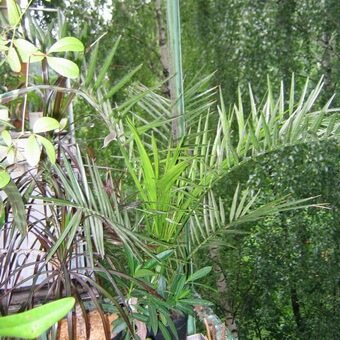

The rocky date palm is an inhabitant of Indian hills and mountainous areas. The culture differs from the rest in that it is smooth-bore - there are no remnants of leaf petioles on the trunk. At the bottom of the trunk, branches branch off, from which new palms grow.
The trunk is slender, has the following dimensions:
- 20 cm diameter;
- 7 meters high.
The leaves are 2-3 m in length. They are pinnate, curved in an arched type. They include bare linear segment sheets, which are placed very densely and sag a little. The length of each segment does not exceed 40 cm. The petioles are short and studded with spines. The fruits are dark red in color.
Pay attention, the date palm of this species is shown in the photo: indeed, the name "stony" fully reflects the way of life of this exotic tree:

